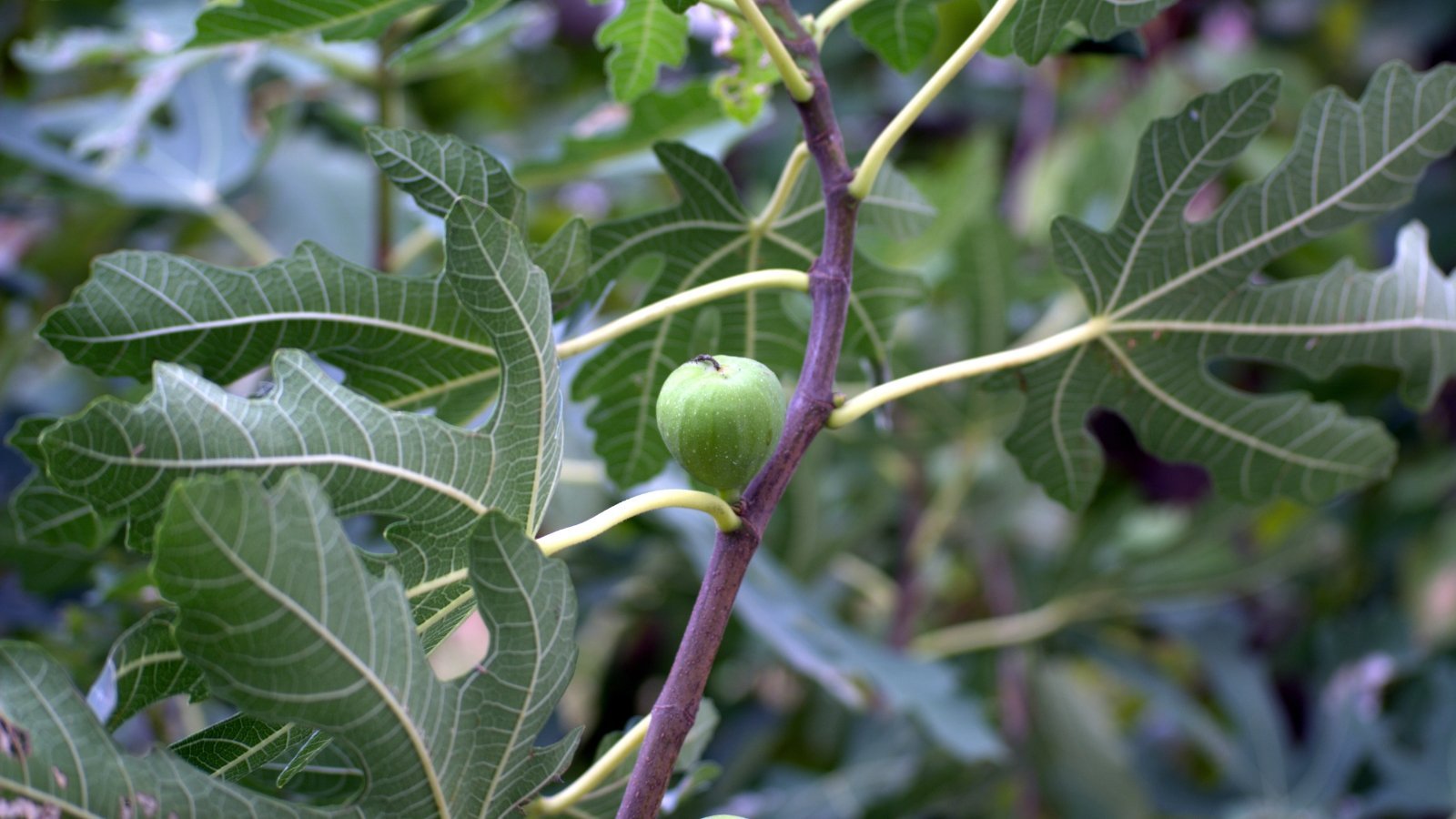Trees are major contributors to a healthy garden ecosystem. They provide shade, add both vertical and horizontal structure, and offer habitat for birds and other wildlife. Trees also provide environmental services, such as producing oxygen and helping to filter groundwater. We can also simply appreciate trees for their beauty.
Whether large or small, trees have highly diverse foliage. We enjoy them as houseplants, compact, container-friendly patio plants, and magnificent, long-lived garden beauties. Each type of tree has something to offer, and when you start to look closely at their leaves, you’ll notice an amazing variety.
Trees aren’t just green. Some are surprisingly colorful, not just during the fall foliage season but all year round. While some have amazingly large leaves, others are adorably tiny or have unusual shapes. Some trees have specially-adapted leaves that help them survive drought or other tough conditions. Next time you look at a tree, pay close attention to its foliage and appreciate how it’s uniquely different from all the other species.
Read on as we introduce 29 wonderful trees and shrubs with unusual foliage guaranteed to liven up your landscape.
Afghan Fig ‘Silver Lyre’
Figs are generally very ornamental trees and small shrubs. The ‘Silver Lyre’ Afghan fig has very showy foliage and makes a lovely landscaping plant within its hardiness zone. These figs are deciduous, losing all their leaves for the winter, although they still maintain an attractively rounded, many-branching form that’s easiest to appreciate when the foliage is gone. During the growing season, enjoy the finely cut five-lobed leaves with their beautiful silvery-green sheen.
Grow your ‘Silver Lyre’ Afghan fig in a sunny location for the best display. These figs will tolerate some light shade but won’t grow as vigorously or as densely as those grown in full sun. Use organically rich, moist, well-drained soil. After a few years, your fig should start producing many small, edible fruits, although if you’re after a highly productive edible fig, we would recommend some other varieties.
American Beech
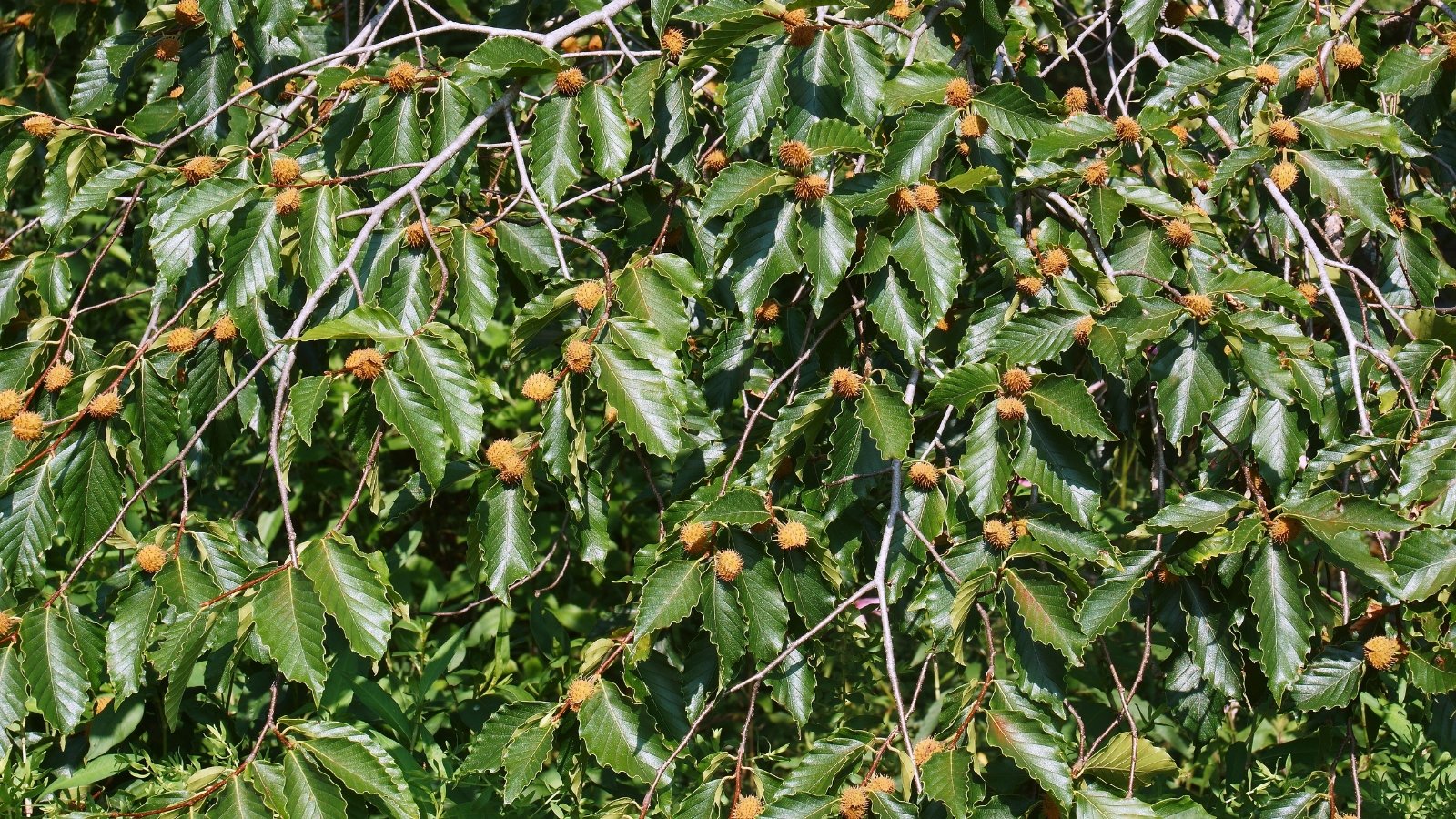
At first glance, there is nothing particularly remarkable about the leaves of an American beech tree. Their unique quality is that they remain throughout the winter. As they dry and turn brown in the fall, they stay on the tree, looking papery and ornamental, until the fresh new spring leaves push off the old ones, and they finally drop to the ground.
American beech is native to moist hardwood forests of eastern North America. These are common understory trees until they reach their mature height and join the forest canopy layer. The distinctive smooth, gray bark adds another unique attribute to the landscape. “Beechnuts” are the spiky husked fruits of the beech tree, which are not only interesting to look at but also edible.
American Holly
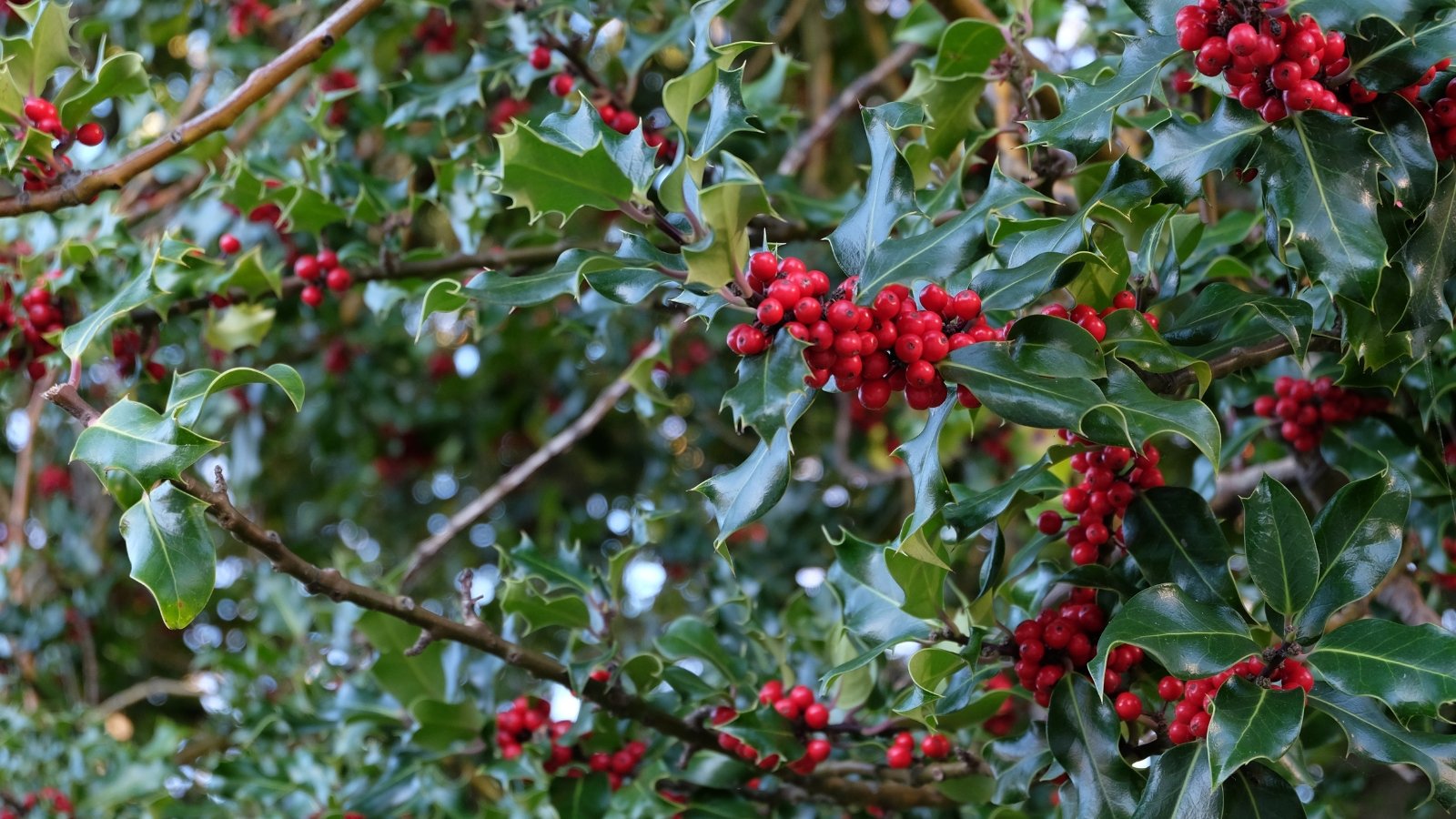
The American holly is a common tree native throughout central and eastern North America. It is a familiar understory tree in many hardwood forests, although it also grows perfectly well in a sunny spot with a bit of afternoon shade. Hollies appreciate moist, well-drained soil, and they do very well in acidic soils.
The American holly makes an excellent landscaping plant. The tough, evergreen leaves offer year-round greenery for a privacy shield or wildlife garden. Each leaf is dark green and ringed with sharp points that protect it from browsing deer. During the winter months, bright red berries mature, providing a valuable food source for winter birds. Hollies make wonderful plants to enjoy in your winter garden.
Bald Cypress
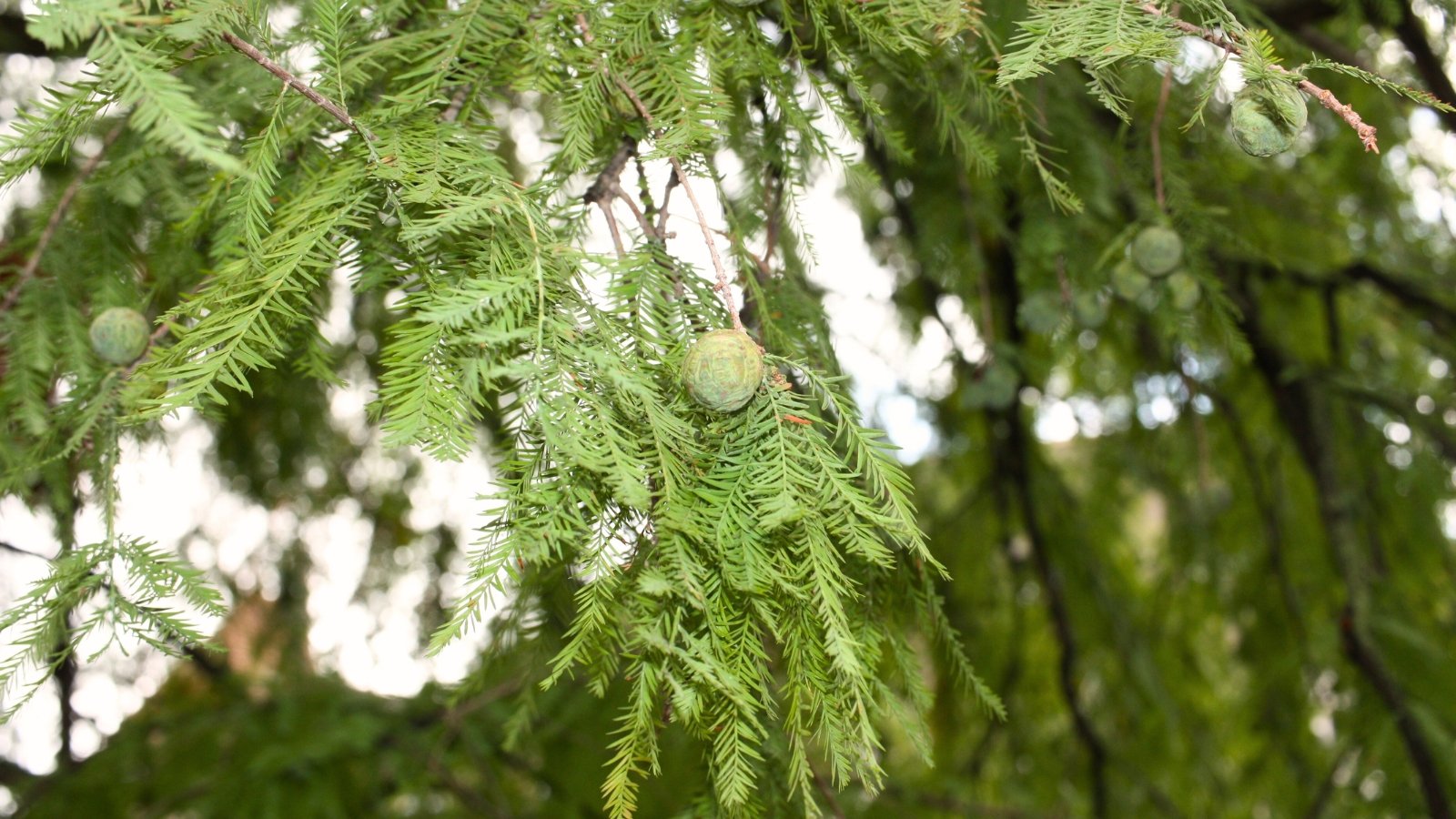
Bald cypress is a characteristic tree of swamps and poorly drained wet soils throughout southeastern North America. It grows well in full sun or partial shade and is one of the few North American trees that thrive in wet soil. Use it along a pond or streamside or as a shade tree for your rain garden.
While many conifers are evergreen, the bald cypress is a deciduous conifer. The bright green, feathery foliage turns bronze-red in the fall before shedding for the winter. This long-lived tree has several other unique characteristics as well. The rounded cones are smooth and ornamental, and the roots have adapted to saturated conditions by growing knobby protuberances, known as knees, above the soil surface.
Banana
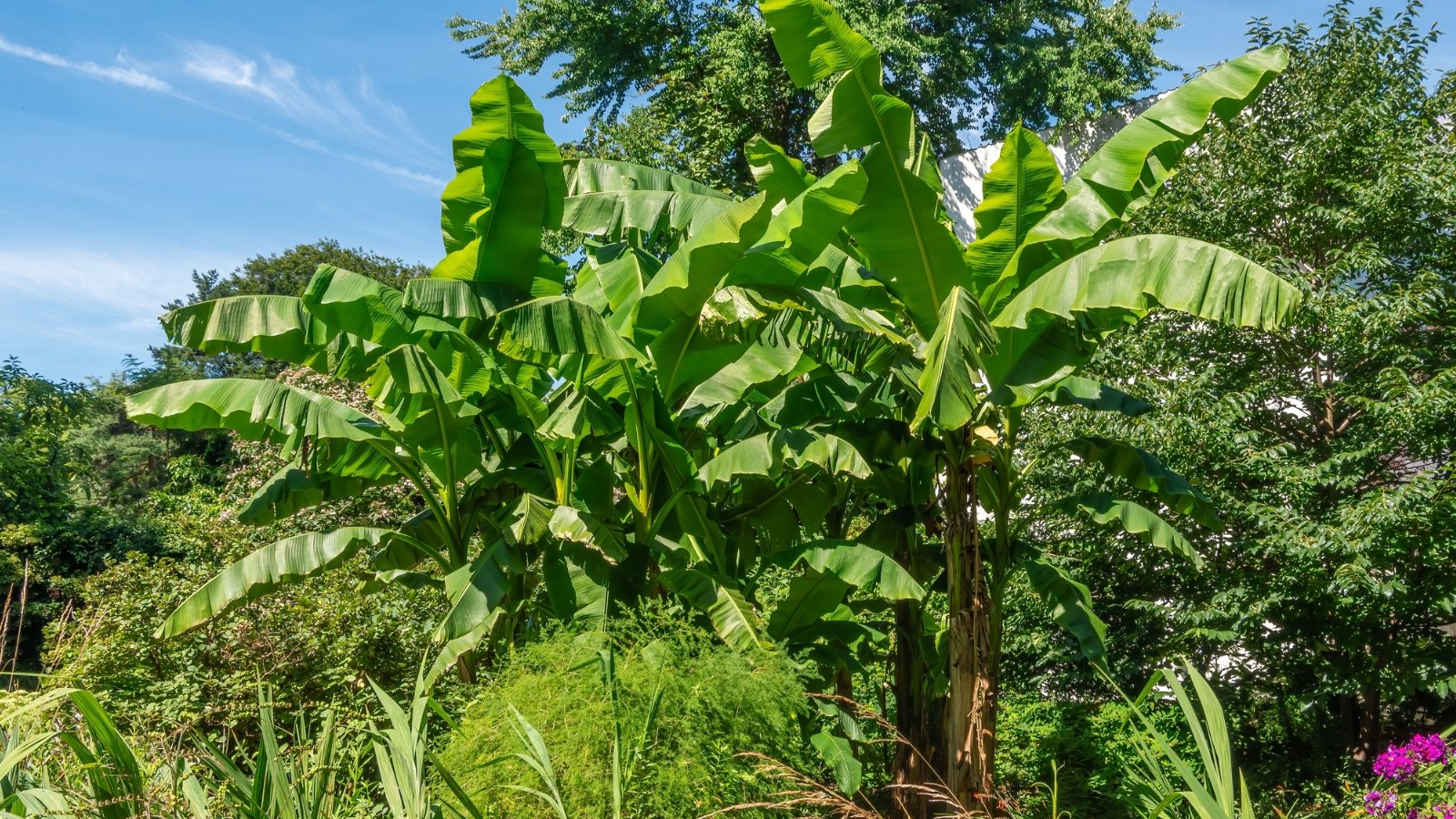
While the banana plant is not technically a tree, it is a fast-growing herbaceous perennial that has some very tree-like qualities. This surprisingly hardy plant can grow over 10 feet tall in a single season. If grown outside, it will die back to the ground after a frost, but a well-mulched plant will easily survive a winter freeze and grow back again the following spring. Alternatively, you can grow Japanese bananas in a large container and bring them in to enjoy their evergreen foliage through the winter.
The first thing you’ll notice when you see a banana plant is its enormous leaves. A single leaf can grow up to six feet long and two feet wide. When you have a strong, sturdy trunk-like stalk topped with a cluster of these broad, bright green leaves, it’s sure to catch your attention. Some banana cultivars have bright red stems and veins, giving them an even more stunning appearance.
Bigleaf Magnolia
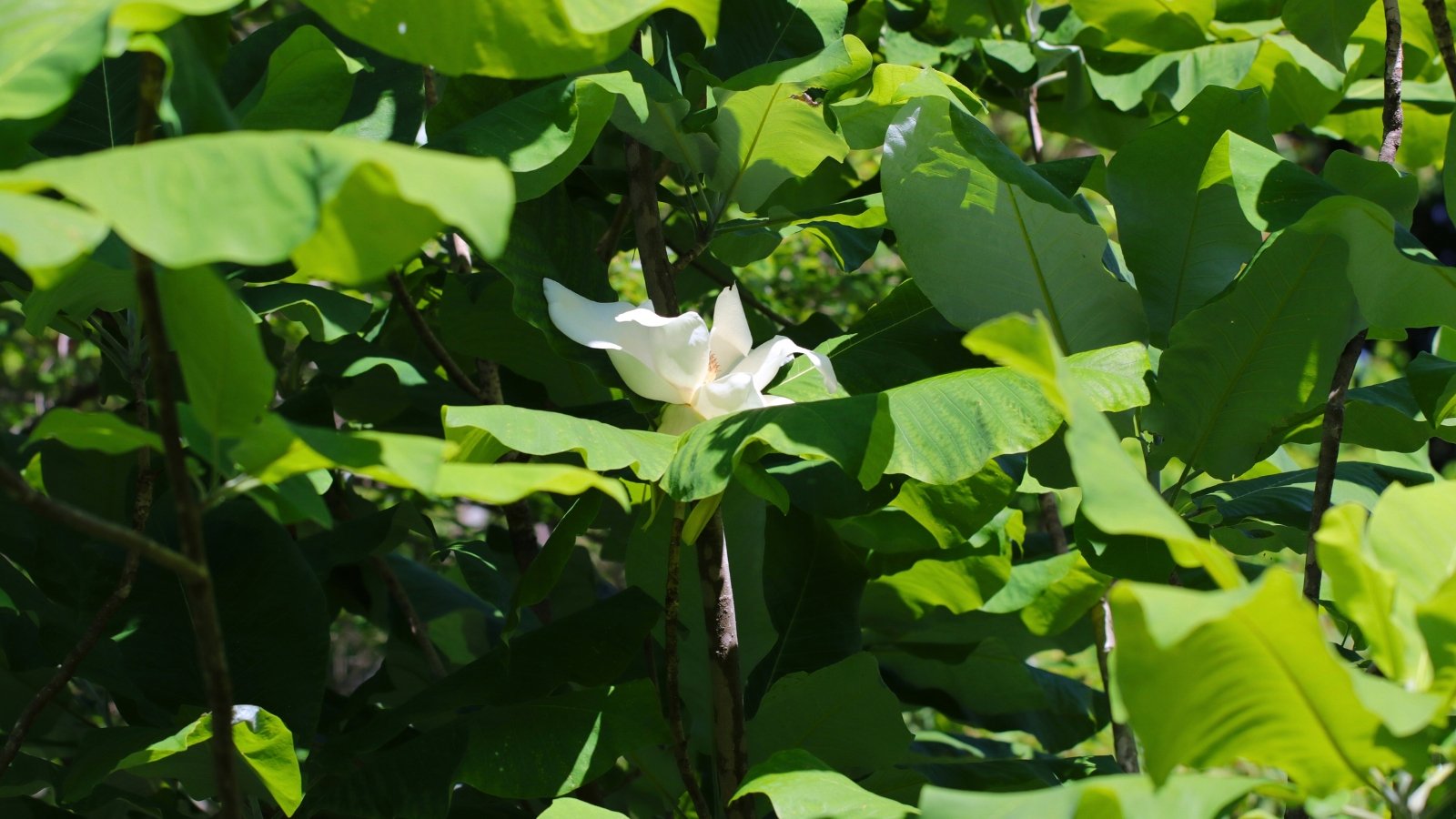
The bigleaf magnolia is a beautiful mid-sized tree native to the southeastern United States. This uncommon tree typically grows only in moist, undisturbed forests. In the home landscape, it would perform best in a cool, moist, partially shaded location. It needs protection from strong winds because the foliage is easily damaged.
Bigleaf magnolia has some of the largest leaves of all the native trees. Each leaf can reach a whopping three feet long and one foot across. The early summer flowers are large, white, and fragrant but can be rather difficult to see through the dense foliage. Check out some of the showy cultivars for a bit more variety, or if you can’t find the native species for sale.
Bigleaf Maple
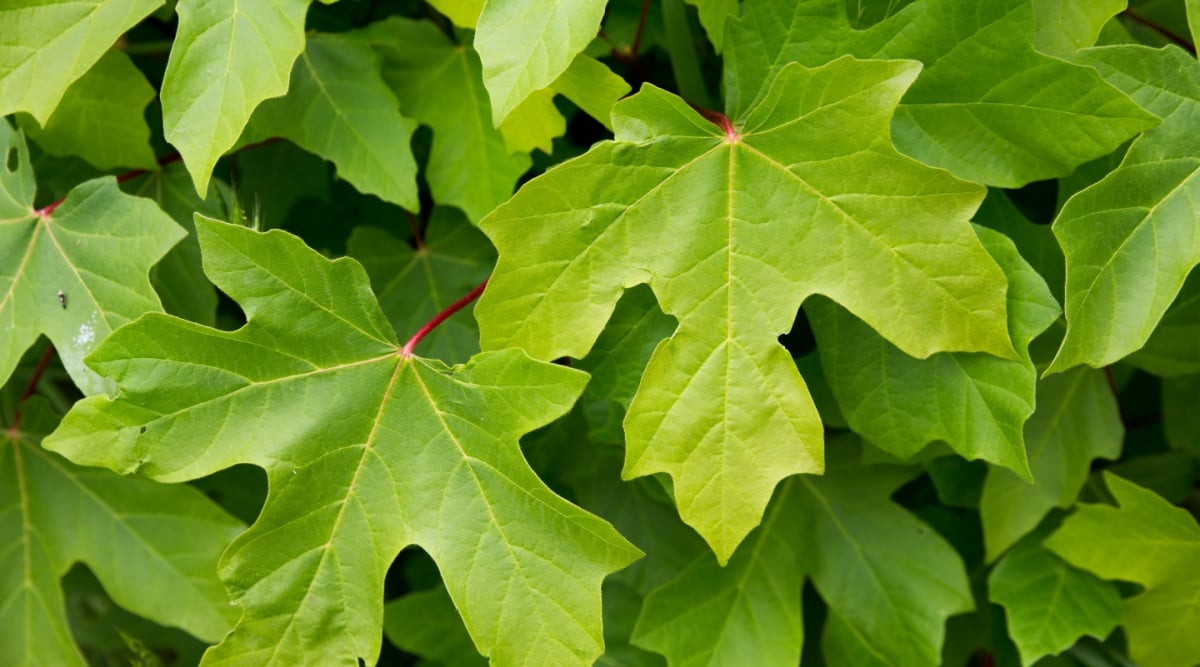
Bigleaf maple, also known as Oregon Maple, is true to its name; this maple tree has big leaves that can measure up to one foot wide. Bigleaf maples are native to the Pacific Northwest where they thrive in cool, moist environments with consistently moist soils. These trees don’t perform well in hot or dry climates.
Bigleaf maples are deciduous trees with deeply cut leaves generally consisting of five distinct lobes. In the fall, they are a showy yellow-orange, making them especially appealing during the autumn foliage season. The overall form of the bigleaf maple is a nicely rounded crown with a thick, stout trunk. Bigleaf maples make excellent shade trees.
Bur Oak
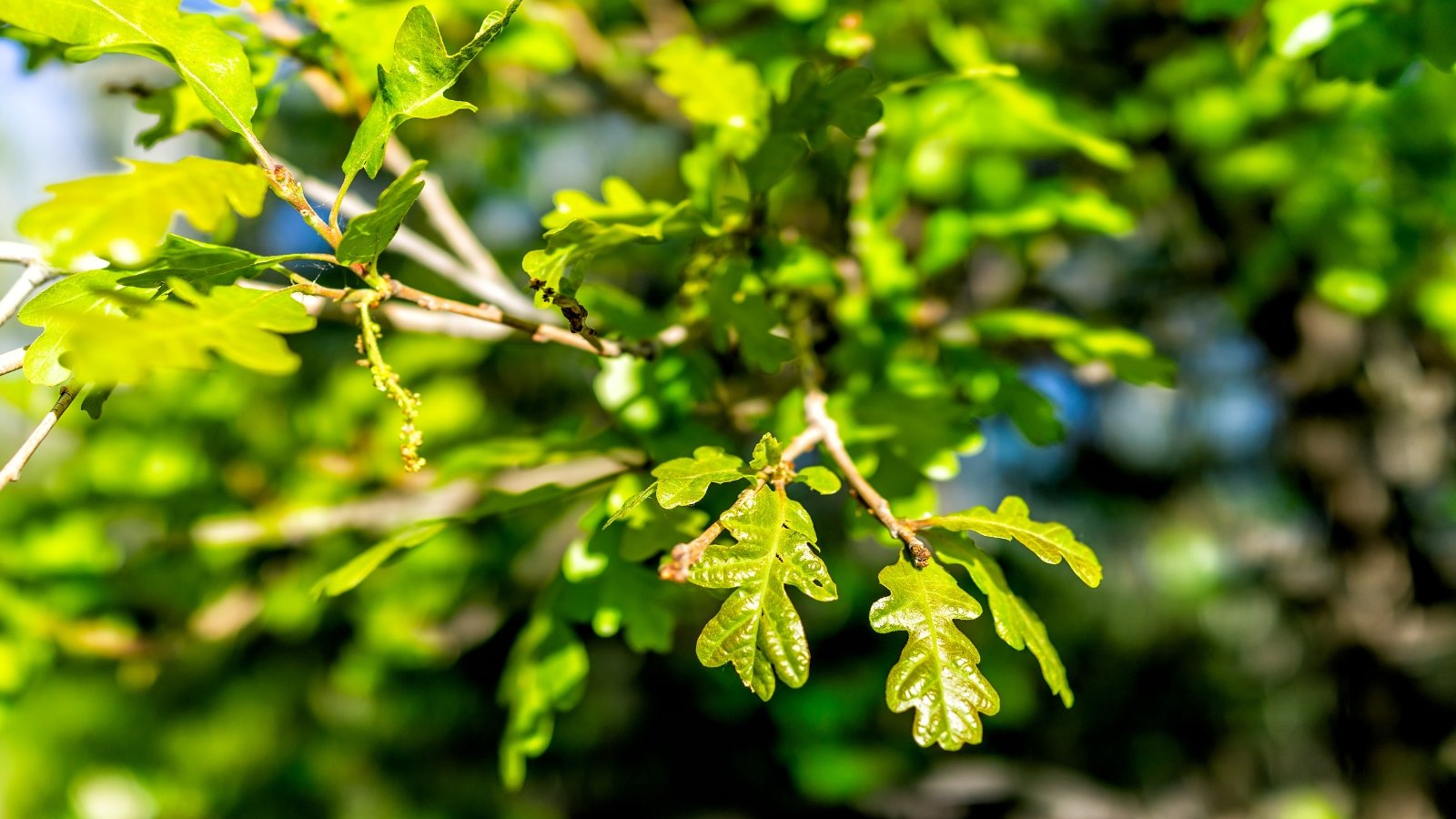
Oak trees (genus Quercus) have amazingly varied leaves, all of which are showy and ornamental. The bur oak has unique leaves that are deeply lobed at the lower end and broadly fan-like at the top half. They are highly variable in shape and often look like a composite of two different leaf types. Bur oaks also have neat-looking acorns with a roughly frilly-edged cap.
The bur oak is native to the northern and northeastern United States and Canada. It is a characteristic tree of open savannas and rich, bottomland forests. The massive trunks support several thick, gnarly, horizontal branches. These make excellent shade trees for a larger yard or in a park-like setting.
Colorado Blue Spruce

The Colorado blue spruce is a beautiful coniferous evergreen that loves cold climates. If you live in a region with lots of summer heat and humidity, a different conifer species would be a better option. Colorado blue spruce thrives in full sun with medium-moisture, well-drained, acidic soil.
The colorful needles of the Colorado blue spruce set this species aside from other conifers. Colorado blue spruce trees develop a lovely conical form and their short, silvery blue-green needles are quite showy. Both close up and at a distance, this is a truly stunning tree as a single specimen or grouped to form a privacy row.
Desert Willow
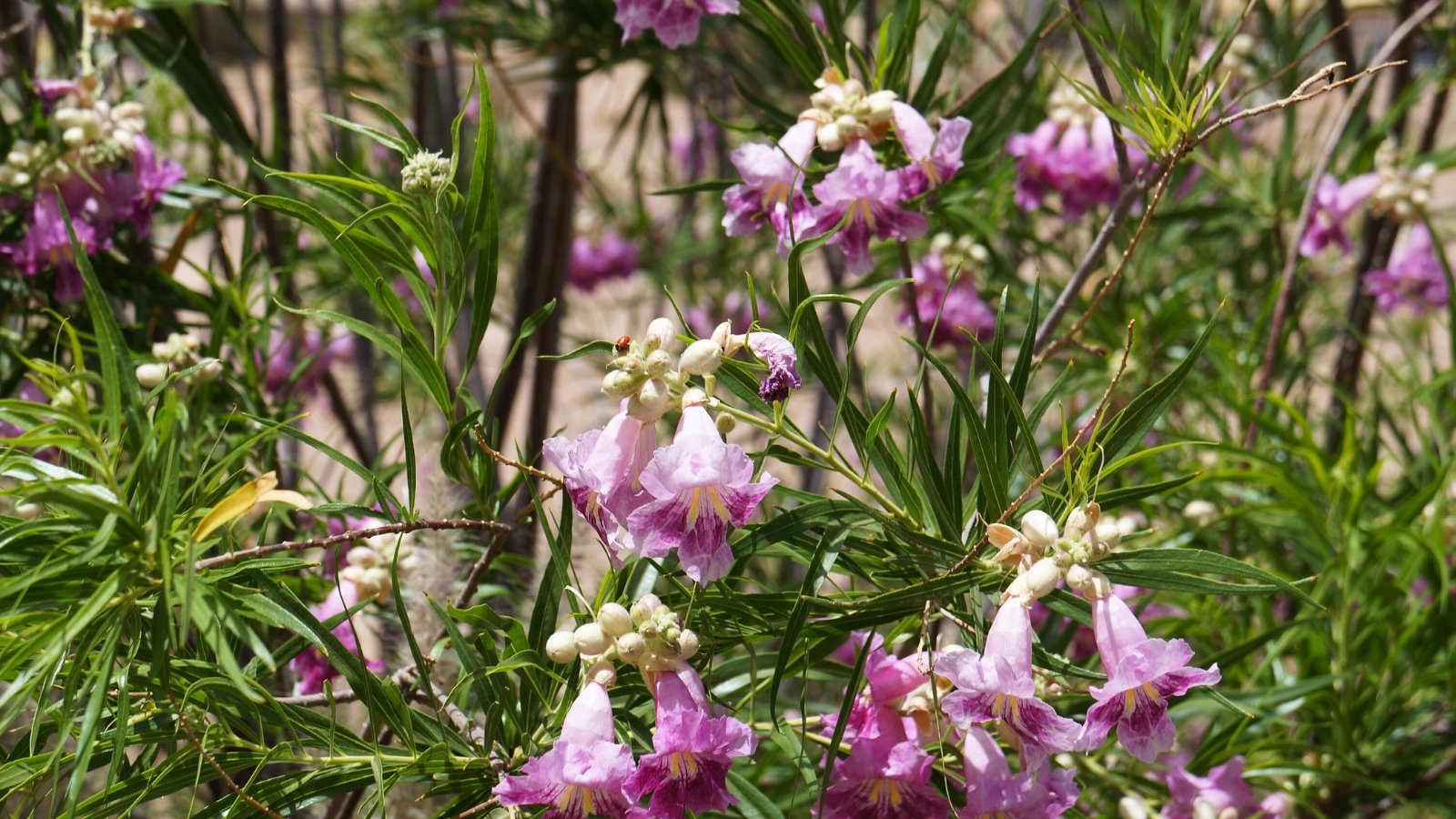
The desert willow is not related to willows but it does live in the desert. Desert willow is a shrub or small tree in the trumpet creeper family. It is native to the southwestern United States and Mexico where it grows in desert arrollos, soaking up quick bursts of water in an otherwise dry environment. These plants are highly drought tolerant and thrive in full sun and well-drained soil. They are especially well-adapted to desert environments.
Desert willow has showy, trumpet-like flowers that bloom from spring until early summer. There are numerous cultivars with very showy flower colors, most notably in varied shades of white, pink and purple, including bi-color blooms. They are very fragrant. The leaves are tough, leathery, bright green, and very thin. The thin leaves reduce the leafy surface area and help these trees conserve their valuable water resource.
Eastern Redbud ‘Forest Pansy’
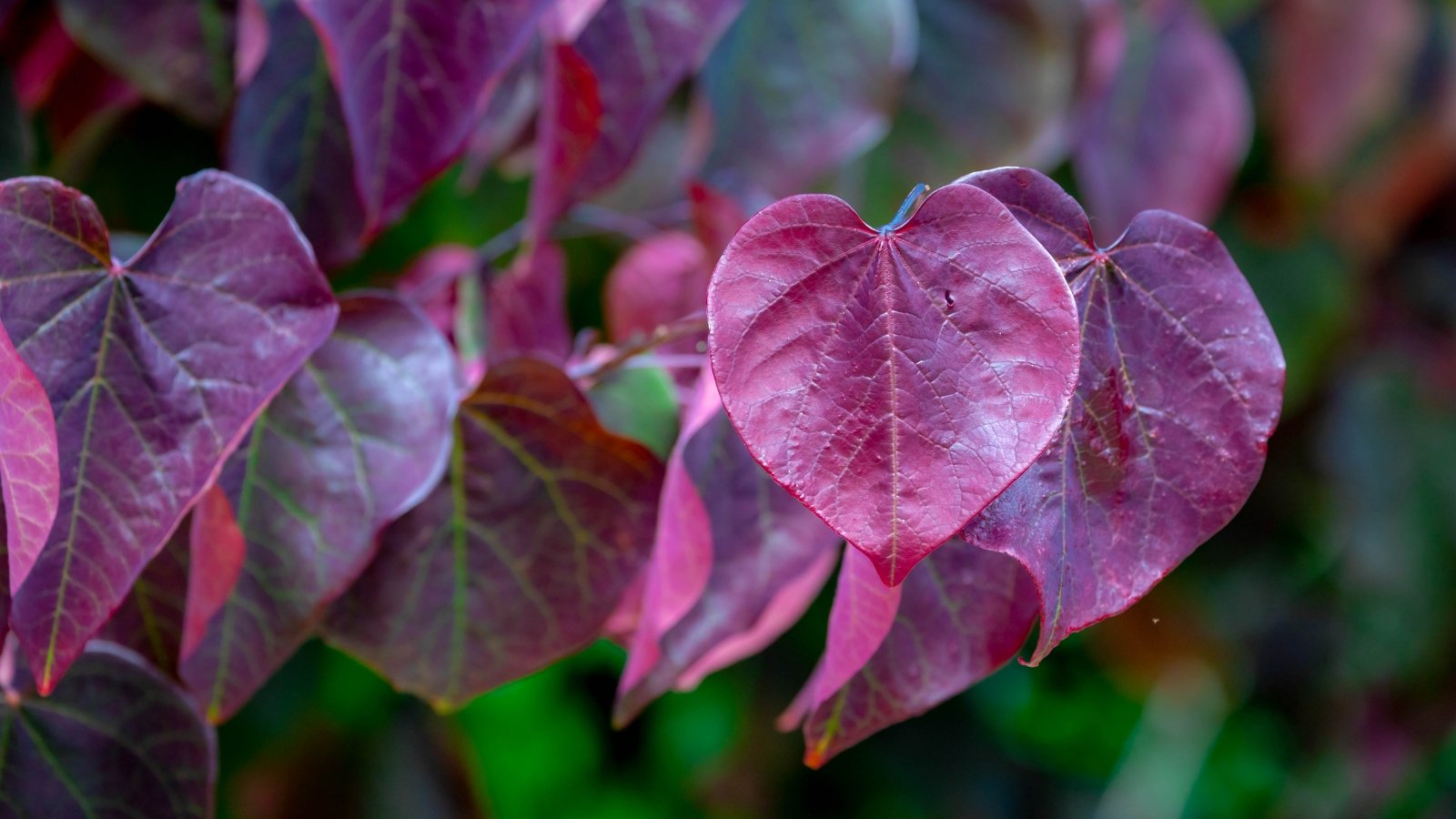
There are quite a few showy redbud cultivars, some with highly ornamental leaves. If you’re looking for some unique foliage, ‘Forest Pansy’ won’t disappoint. This redbud variety has the typical heart-shaped foliage and masses of spring-blooming, bright pink, pea-like flowers. During the growing season, the leaves are purplish-green, and in the fall, they change to varying shades of magenta and orange.
Eastern redbuds are native to central and eastern North America. They are common understory trees and have a high tolerance for partially shaded sites. Grow it in average-quality, moist, well-drained soil. ‘Forest Pansy’ would make a wonderful small tree to plant in a prominent place to increase your home’s curb appeal.
Eastern Redbud ‘Rising Sun’
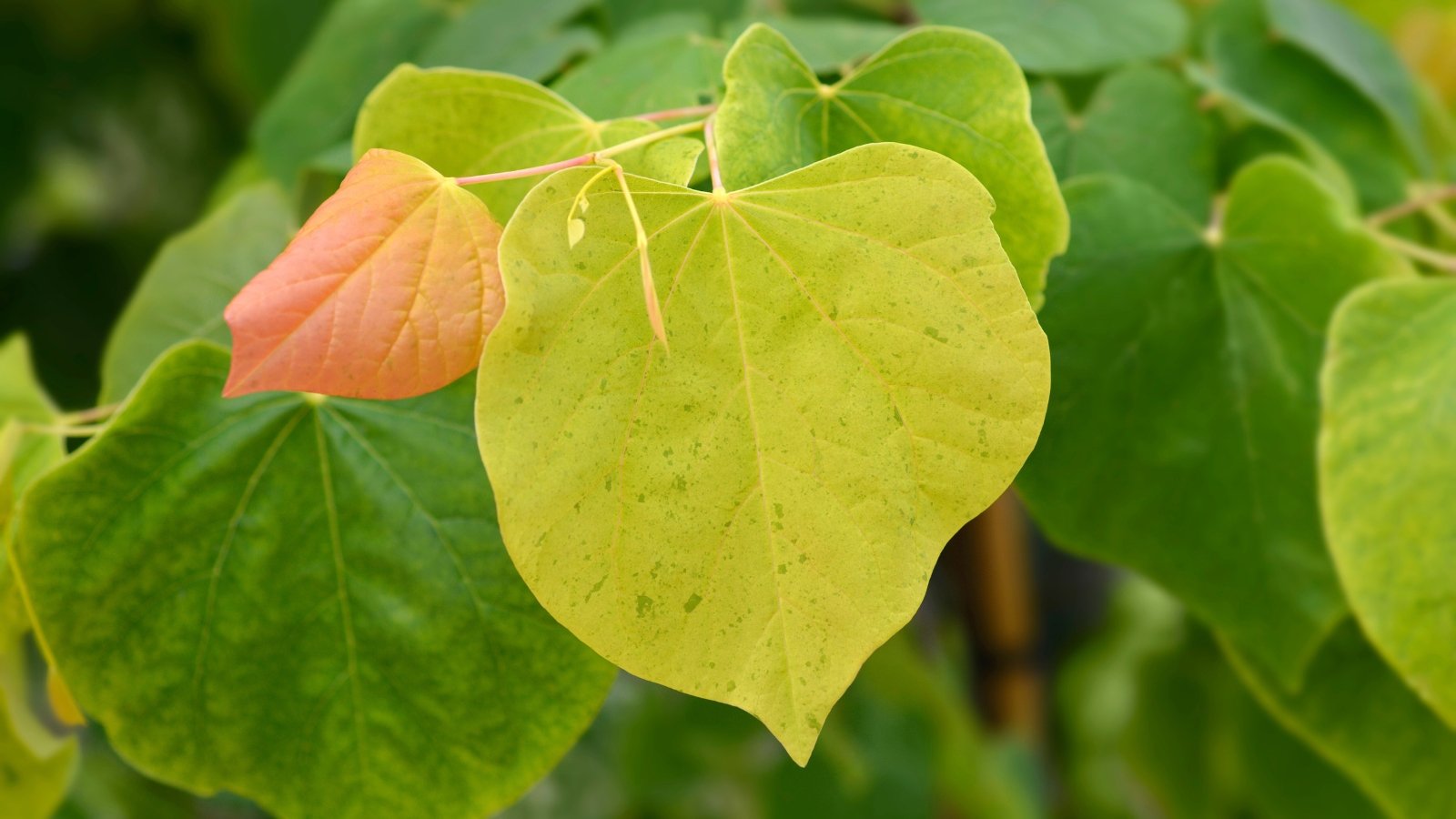
‘Rising Sun’ is another beautiful redbud cultivar that’s worthy of some attention. This showy redbud has unique leaves that change color from emergence to maturity. Fresh, young leaves emerge as a showy red-orange color, reminiscent of the rising (or setting) sun. As they mature, they shift to yellow-orange, then yellow, and finally to deep green. During peak growing season, ‘Rising Sun’ displays all of these colors at the same time for a highly ornamental display.
‘Rising Sun’ redbuds are fairly small trees, more shrub-like in appearance than the standard redbud species. Use this tree as a seasonal privacy hedge or in any wildlife-friendly landscape. The spring-blooming pink flowers attract pollinators, birds, and small mammals, and the dense, leafy branches provide shelter, foraging, and nesting opportunities for birds.
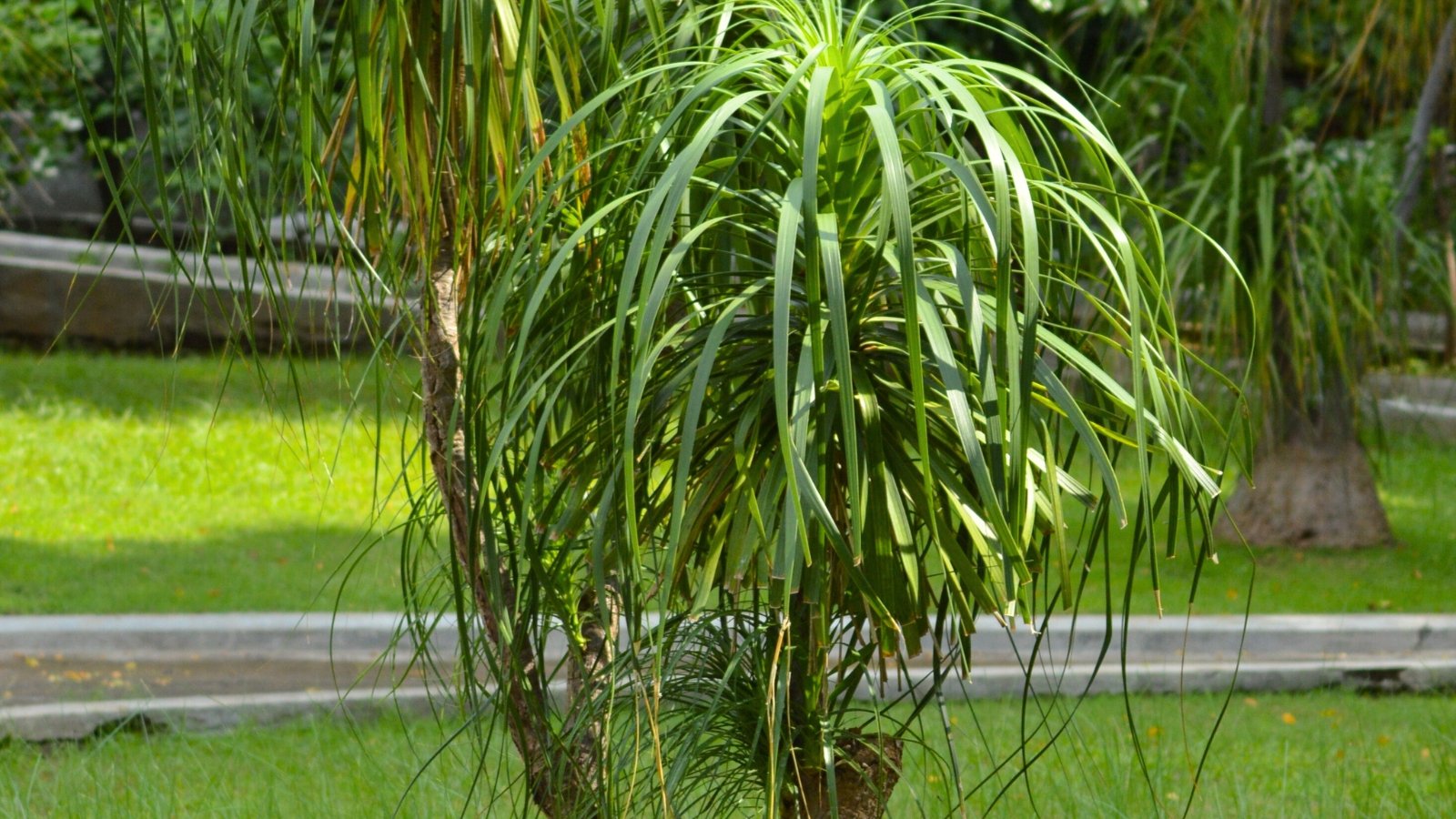
The elephant foot tree, also known as the ponytail palm, is a broadleaf evergreen native to southern Mexico and the northern region of Central America. This plant is best known as a houseplant, as it is slow-growing and adapts easily to life in a pot. Elephant foot tree is drought tolerant and requires well-drained soil.
The elephant foot tree is a shrub or small tree. In its native habitat, it can form a huge rounded base and grow up to 30 feet tall, but as a houseplant, it will stay much smaller. Each plant has a large, bulbous base, from which rises a single trunk-like stem. At the top of the stem, these plants develop a leafy cluster of dramatically long, thin leaves that curve and spiral down. Each leaf can be several feet long in mature plants. The older ones closer to the base eventually yellow and die while new leaves slowly emerge from the central top cluster.
Feather Bush
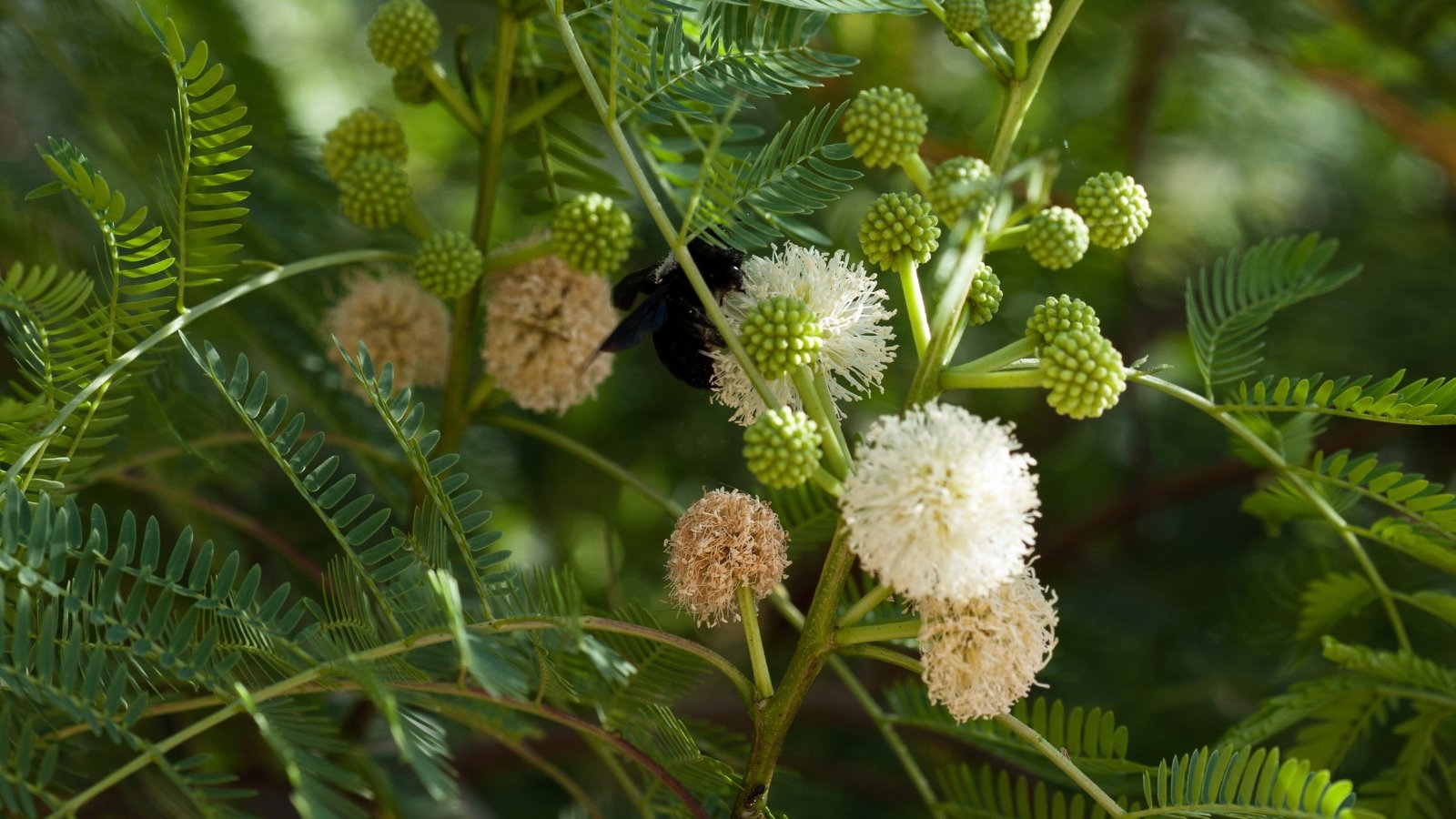
The feather bush is a heat-loving, drought-tolerant shrub or small tree native to southern Arizona and the Mexican desert. Feather bush has deciduous foliage, losing its leaves during the winter, and also as a way to conserve water during prolonged drought. It requires well-drained soil and is an excellent choice for your xeriscape, but only if you live in a warm, dry, desert climate.
Feather bush has very attractive feathery foliage. Each leaf is symmetrical and divided into dozens of tiny leaflets. Fluffy round white flowers bloom in the spring, resembling little snowballs adorning the trees. Pollinators come to feed on the flowers and birds will use these trees for perching, foraging, and nesting opportunities.
Fiddle Leaf Fig
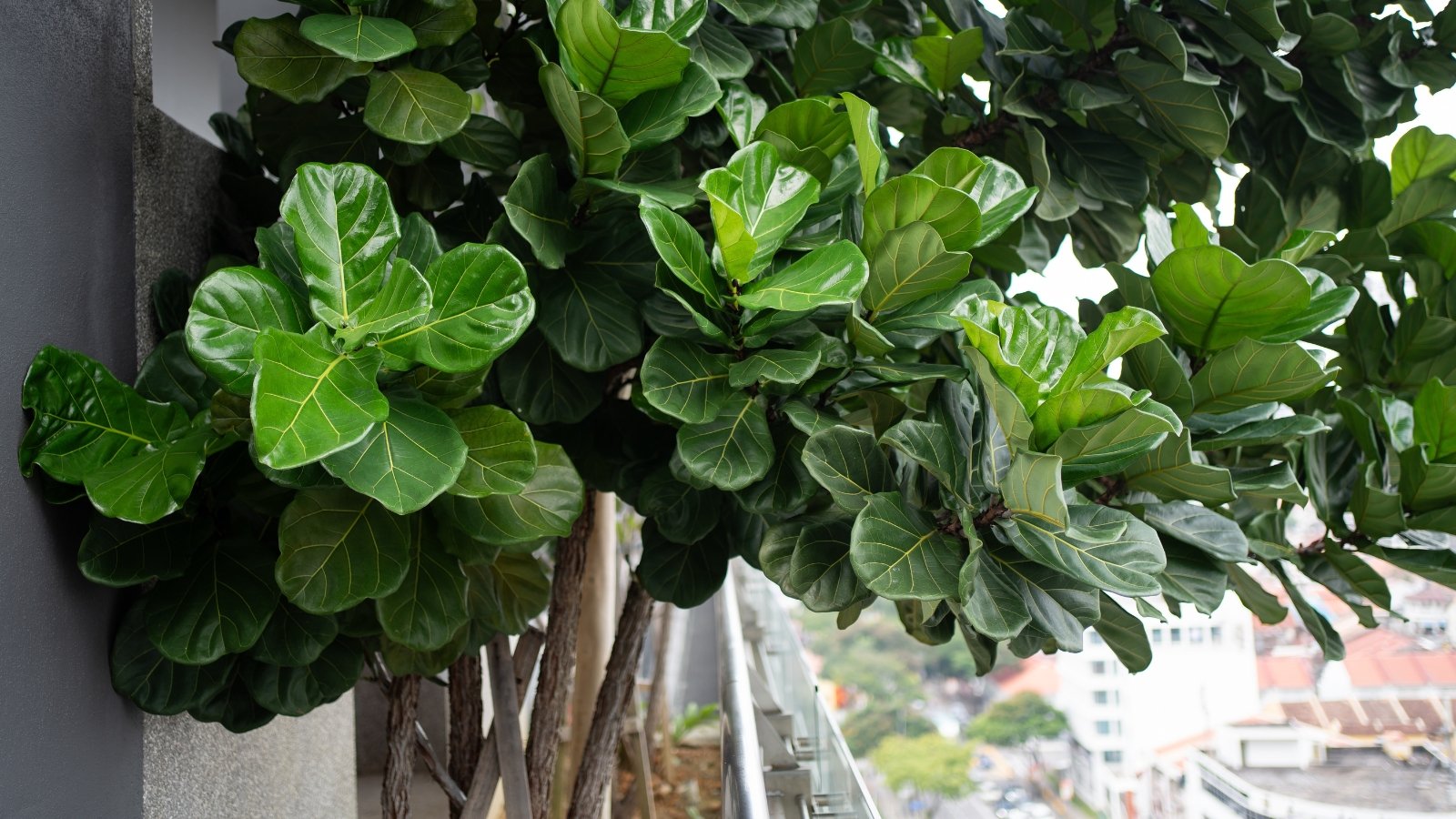
The fiddle leaf fig is a popular, easy-to-grow houseplant known for its attractive foliage. In its native habitat in tropical western and central Africa, it can grow up to 100 feet tall, but as a houseplant, it rarely grows more than 10 feet tall. Give your fiddle leaf fig a warm location with bright, indirect light and moist, well-drained soil.
Fiddle leaf fig has large, showy leaves. Each leaf can grow up to a foot long and six inches wide. They have a tough and leathery surface with prominent veins on the underside. Some have a shape that resembles a fiddle or lyre, hence the common name. Be aware that if you are growing this plant indoors, it contains a milky white sap that is toxic if ingested. Keep this plant away from curious cats, dogs, and children. The sap can also cause skin irritation when handled.
Ginkgo
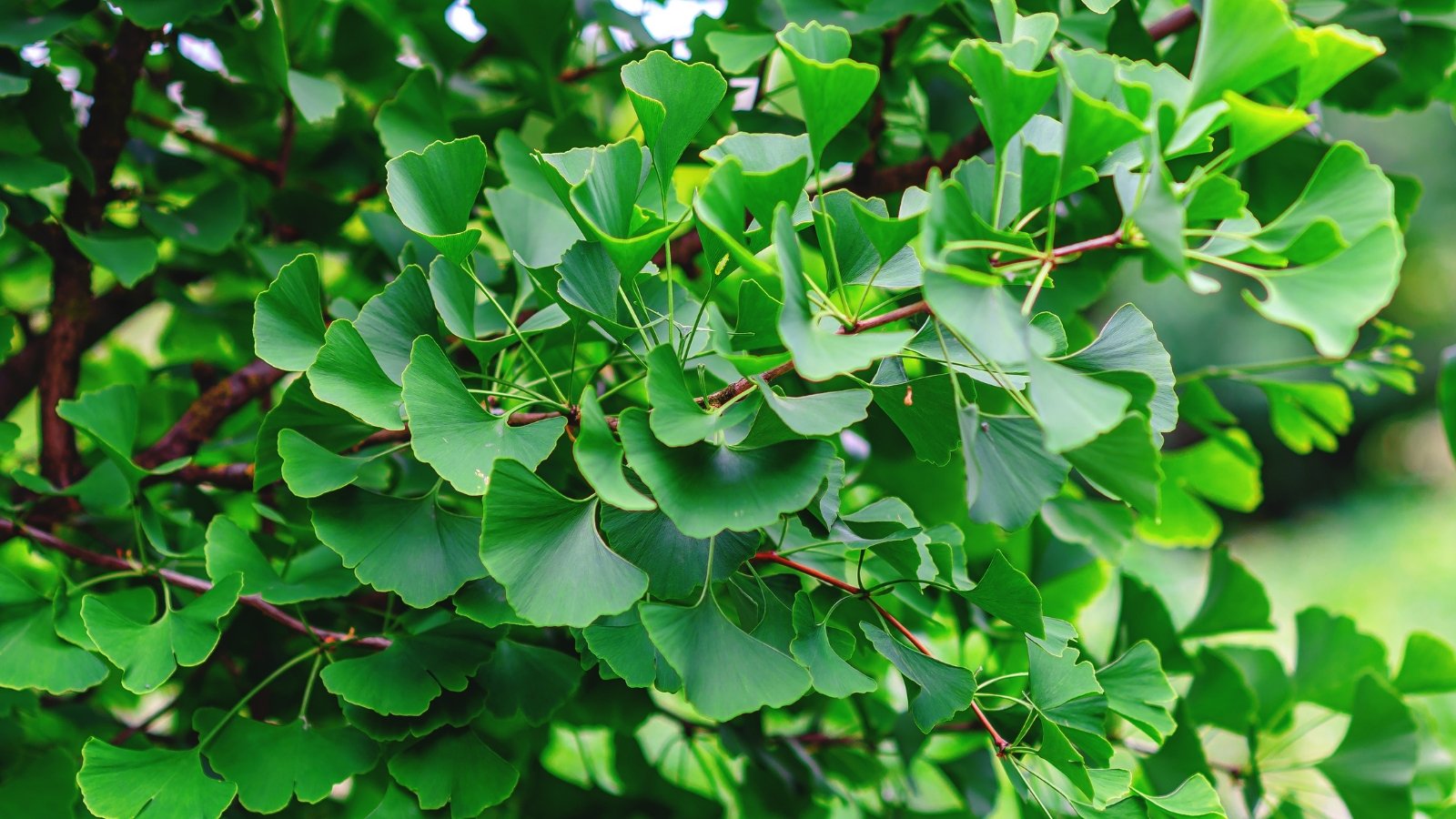
The ginkgo is an easy-to-grow ornamental tree from southern China. Ginkgos are somewhat slow growing, but given enough time, mature trees can reach a height of 80 feet and make excellent shade trees in a larger, spacious setting. These trees perform best in full sun with medium-moisture, well-drained soil.
Ginkgos are fascinating ancient trees that are well-represented in the fossil record. Ginkgo leaves are distinctly unique, unlike most other living trees. They are fan-shaped and often display two separate lobes, hence the species name, “biloba.” Mature trees develop an appealing pyramidal shape and become lovely shade trees. In the autumn, the foliage turns from bright green to golden yellow, before dropping for the winter months.
Japanese Maple ‘Crimson Queen’
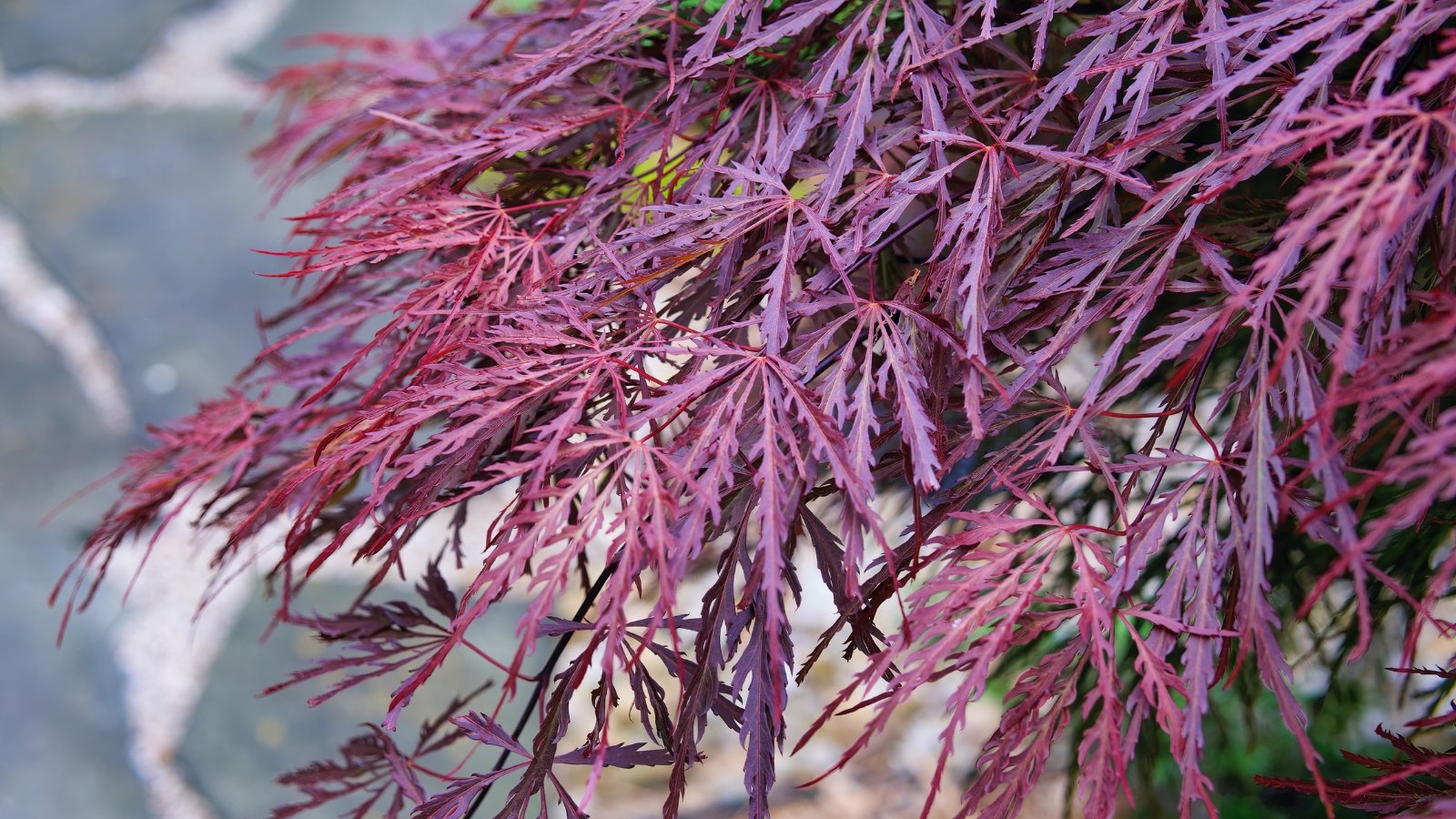
Japanese maples are some of the showiest trees around, and all have beautiful foliage. The ‘Crimson Queen’ cultivar is a compact tree with dense foliage and a broad, spreading crown with slight weeping tendencies. These versatile trees can be grown in small spaces, including containers, wherever you might appreciate a compact, ornamental tree.
‘Crimson Queen’ has very unique leaves. Each is deeply cut into five or seven thin, serrated lobes, giving them a somewhat finger-like appearance. During the growing season, the leaves may be mostly green, but are more typically shades of red or burgundy. In the autumn, they turn yellow and orange before dropping for the winter.
Japanese Umbrella Pine

The Japanese umbrella pine is a slow-growing needled evergreen native to Japan. In the wild, it can reach up to 100 feet tall, but it generally stays considerably smaller in cultivation. This tree prefers a sunny location with rich, moist, well-drained soil. Japanese umbrella pine does best in cooler climates with mild summers. In the landscape, use it as a year-round privacy hedge or a central accent plant to add a dramatic statement.
Japanese umbrella pine has very stiff, thick needles. The needles grow in spiky whorls around the stems, and when stacked together at the ends of the branches do resemble the spokes of a parasol. Larger trees develop a very uniform, pyramidal shape and make a very attractive landscaping plant and can even be grown in a container or used for bonsai.
Monkey Puzzle Tree
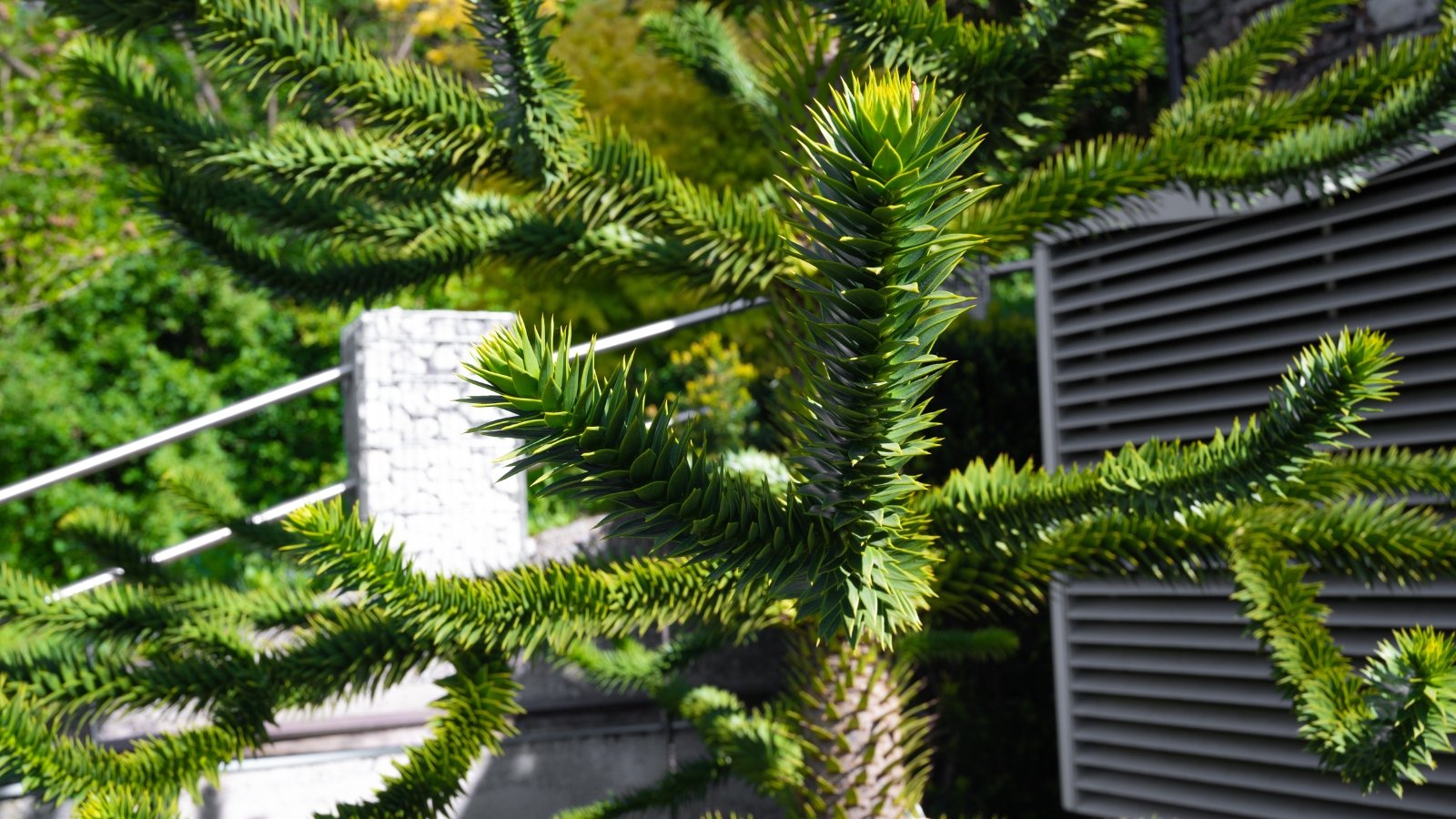
The monkey puzzle tree is a fascinating tree native to Chile and Argentina. These trees perform well in either full sun or light shade and they are not picky about soil quality, as long as it’s well-drained. Monkey puzzle trees make interesting landscaping plants if you live in a climate with a relatively cool and mild summer. Young trees can be grown in containers and brought indoors for the winter months.
Monkey puzzle trees are needled evergreens. A close examination of the leaf-lined stems reveals a most unusual leaf pattern. The triangular wedge-like needles are tightly packed and sacked closely together, lining each of the long and branching stems. At a distance, this leaf pattern gives these trees the appearance of having thick, green, ropy stems and branches, creating an interesting architectural display.
Quaking Aspen
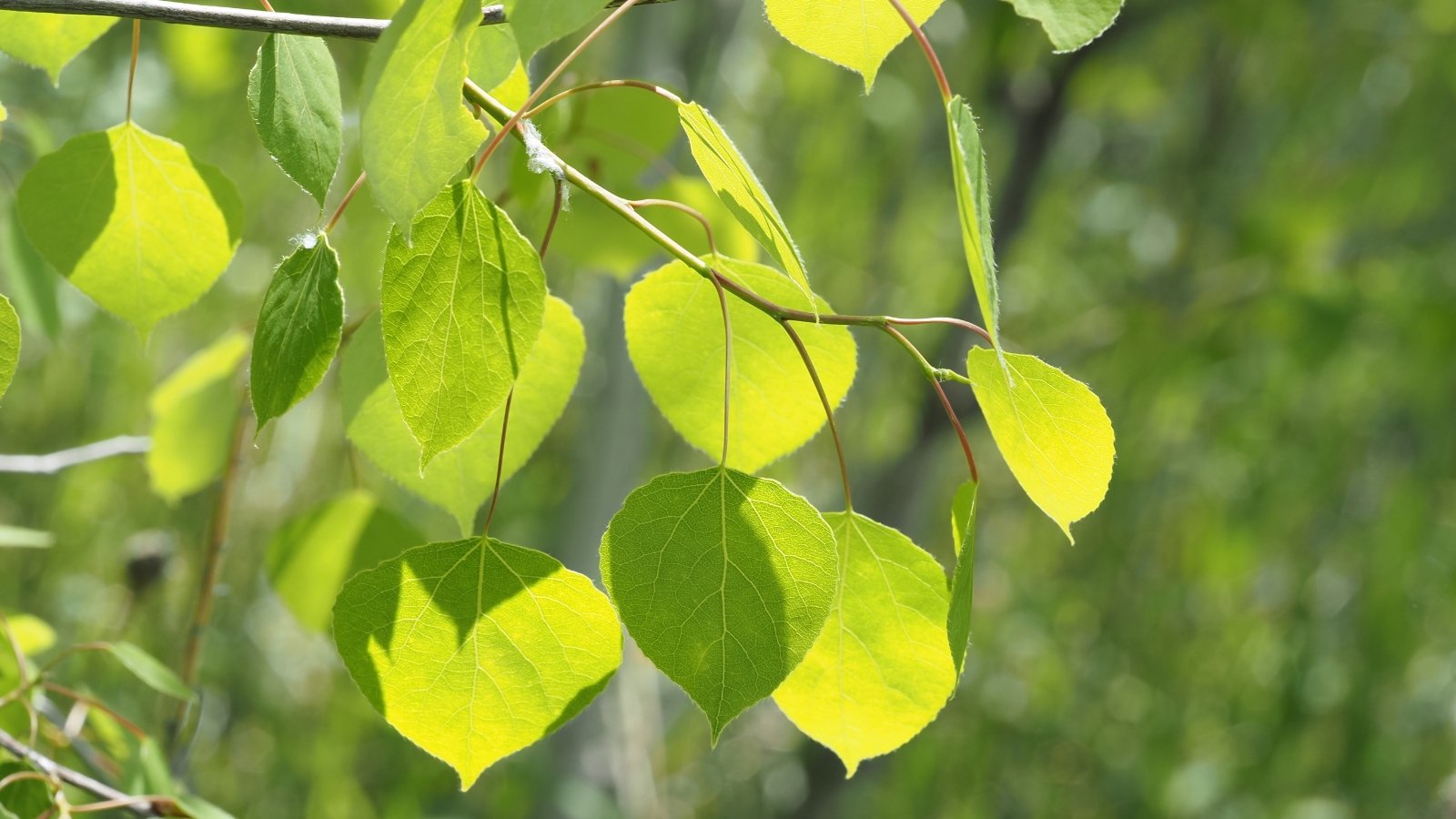
If you’re looking for a beautiful, cold-loving, colony-forming tree, check out the quaking aspen. Quaking aspens are native throughout the cooler climates and mountainous regions of most of North America, except for the southeastern states. They need a sunny location with consistently moist, well-drained soil.
Quaking aspens are easily recognized by their smooth, white bark and rounded, tooth-edged leaves. On breezy days, all the leaves catch the wind to flutter and quake, giving rise to the name quaking aspen. These trees have beautiful golden-yellow fall color.
Red Buckeye
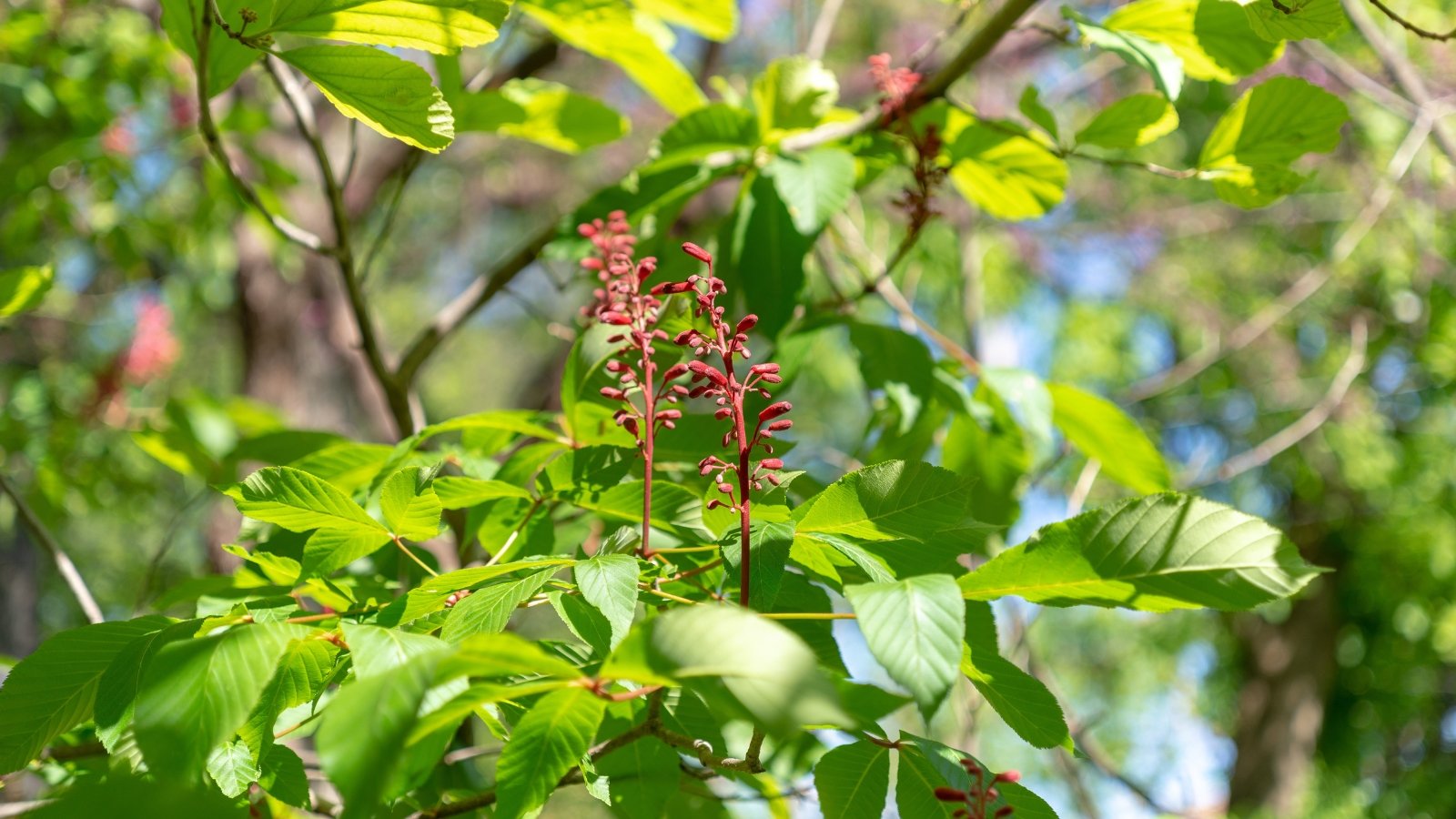
Red buckeye is a deciduous shrub or small tree native to eastern North America. It grows naturally as an understory shrub in moist, shaded forests and is an important spring-blooming pollinator plant. Hummingbirds love the tubular, bright red flowers, and plenty of insect pollinators also come to sip nectar.
The red buckeye has distinctive leaves that are easy to recognize, even when this shrub isn’t in bloom. The pinnately compound leaves are typically a rounded grouping of five to seven leaflets, each six to seven inches long. The overall appearance is of a big, green, five-pointed star. Red buckeye is a wonderful addition to a woodland garden, hummingbird garden, or native plant landscape.
Sassafras
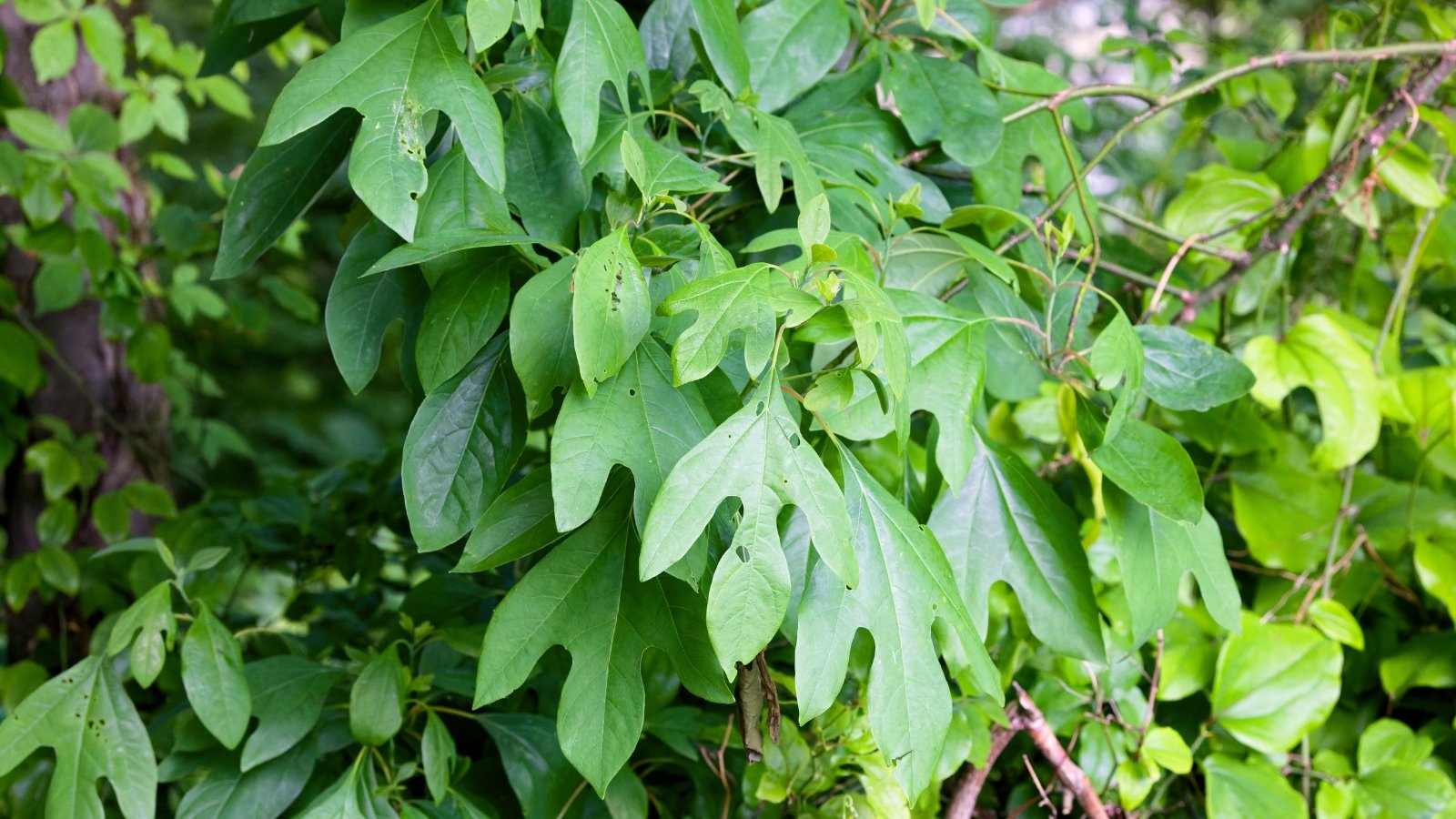
Sassafras is a beautiful small to medium-sized tree native to moist hardwood forests of eastern North America. It is generally an understory plant in its natural habitat and performs well in a partially shaded plot with moist, well-drained soil. Sassafras forms colonies and would be good for a larger naturalized area or be prepared to thin unwanted root suckers.
One of the most distinguishing features of sassafras is its foliage. Sassafras leaves come in three different shapes all on the same tree: a simple oval shape, an asymmetrical two-lobed mitten shape with thumb, and a symmetrical three-lobed shape. The fall foliage colors are impressive and include yellow, orange, and varying shades of red.
Silver Dollar Gum
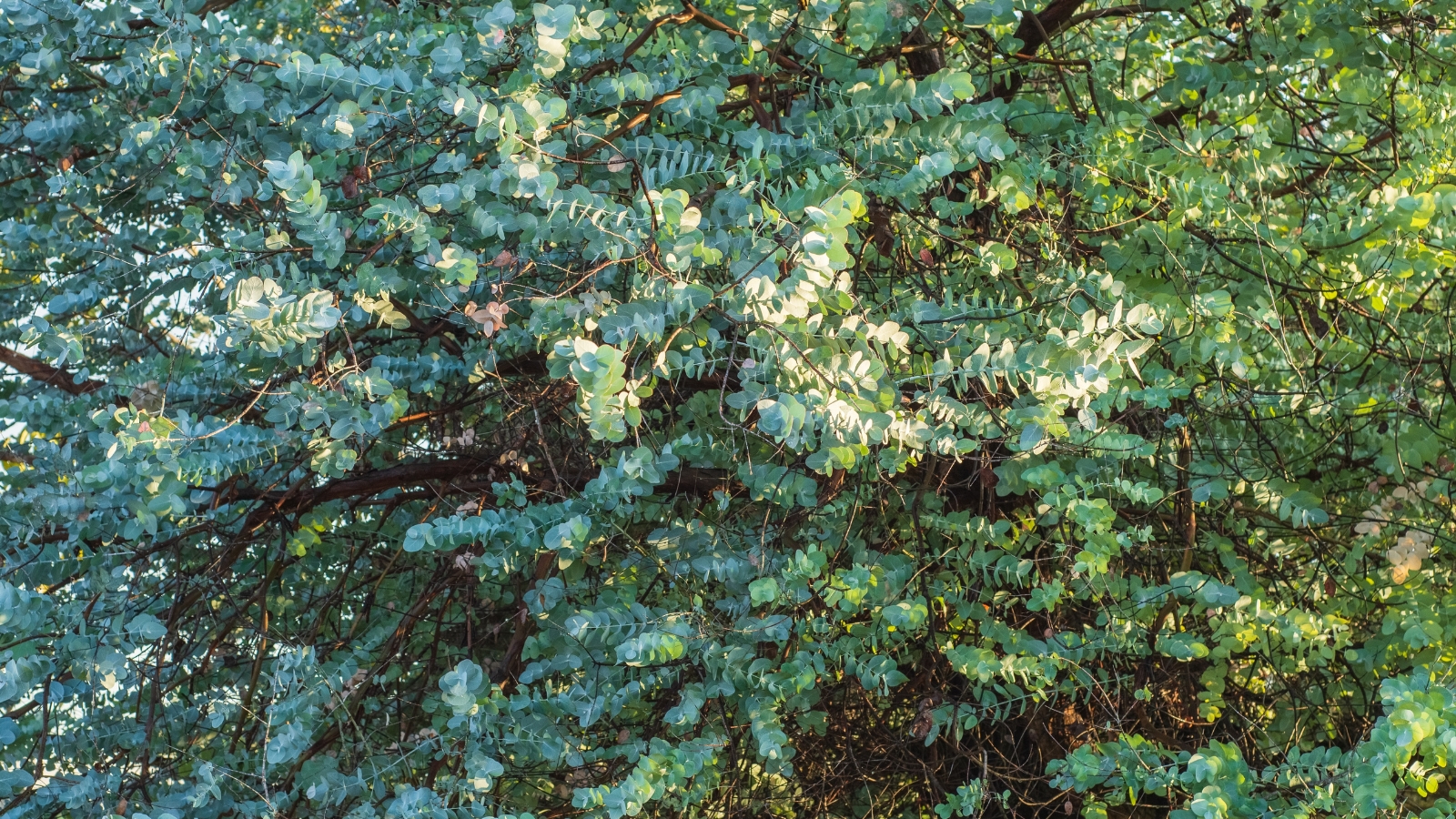
The silver dollar gum is an evergreen eucalyptus tree native to Australia. This ornamental tree is winter hardy only in warm and generally frost-free environments. In cooler climates, it can be grown in a large container, but you’ll need to bring it in for the winter months to keep it in a sunny window. You can also grow a silver dollar gum as a fast-growing annual shrub. Eucalyptus trees need well-drained soil.
Silver dollar gum trees can grow very large, so if you are in a warm climate and growing this tree outdoors, give it plenty of space to spread. These eucalyptus leaves are silvery-green and rounded, arranged in opposite pairs along the stems. They have a characteristic eucalyptus scent when rubbed or crushed, and the leafy stems of these trees are often incorporated into dried flower arrangements.
Southern Magnolia
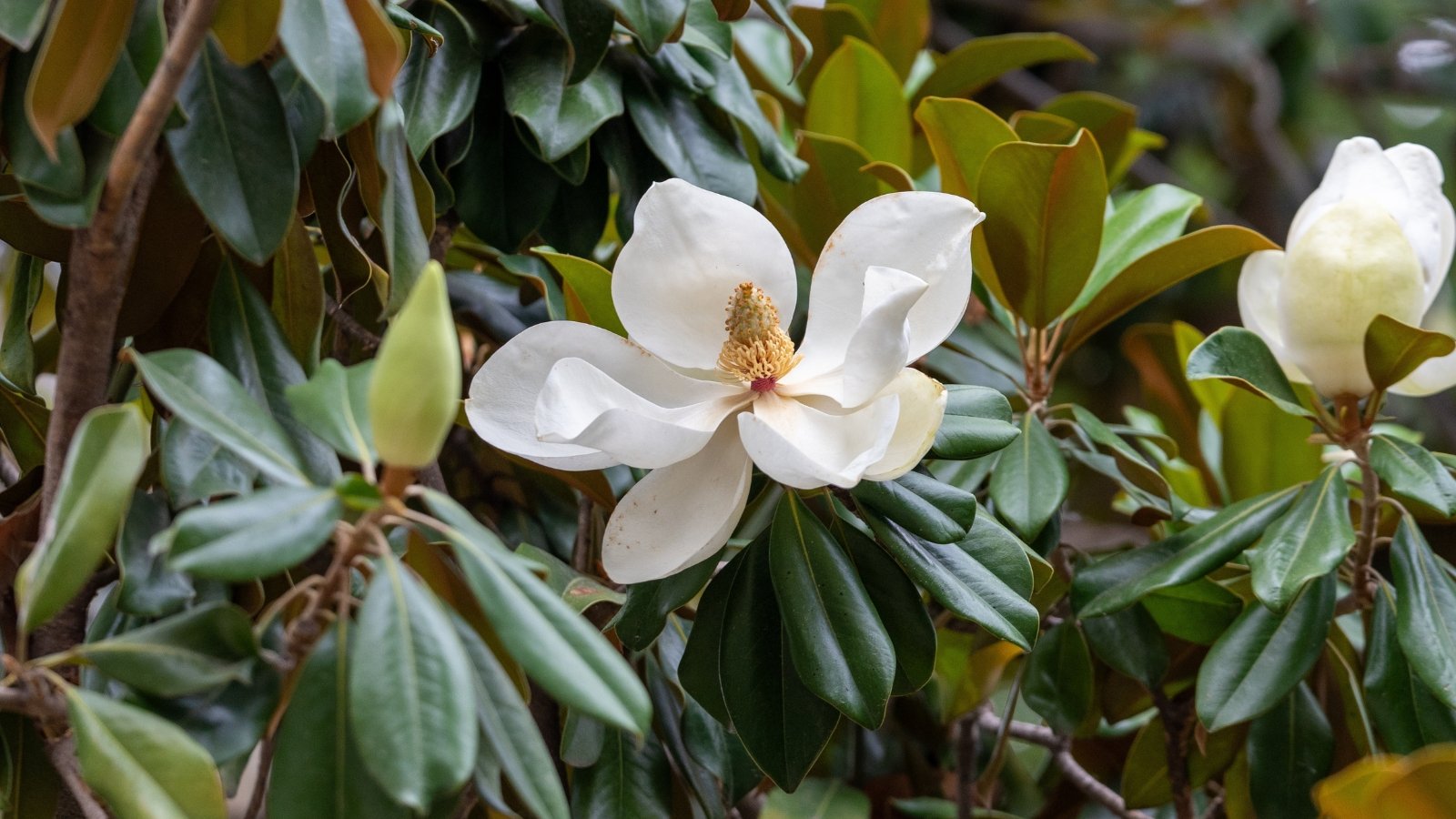
Southern magnolia is a very common landscaping tree in its native range throughout the southeastern United States. These impressive trees are broadleaf evergreens, retaining their jumbo-sized leaves throughout the winter. While the upper surface of each leaf is tough and glossy, the undersides are covered with a light brown, downy fuzz that is very soft to the touch.
If a mature height of 80 feet seems too much, try one of the many dwarf varieties of Magnolia. Southern magnolia has not only impressive leaves but also spectacular flowers. The richly scented flowers are huge and white, blooming in the springtime and attracting a variety of pollinators. After flowering, southern magnolia trees produce ornamental seed capsules that look like fuzzy exotic fruits until they dry and crack open to reveal numerous bright red seeds.
Spinning Gum
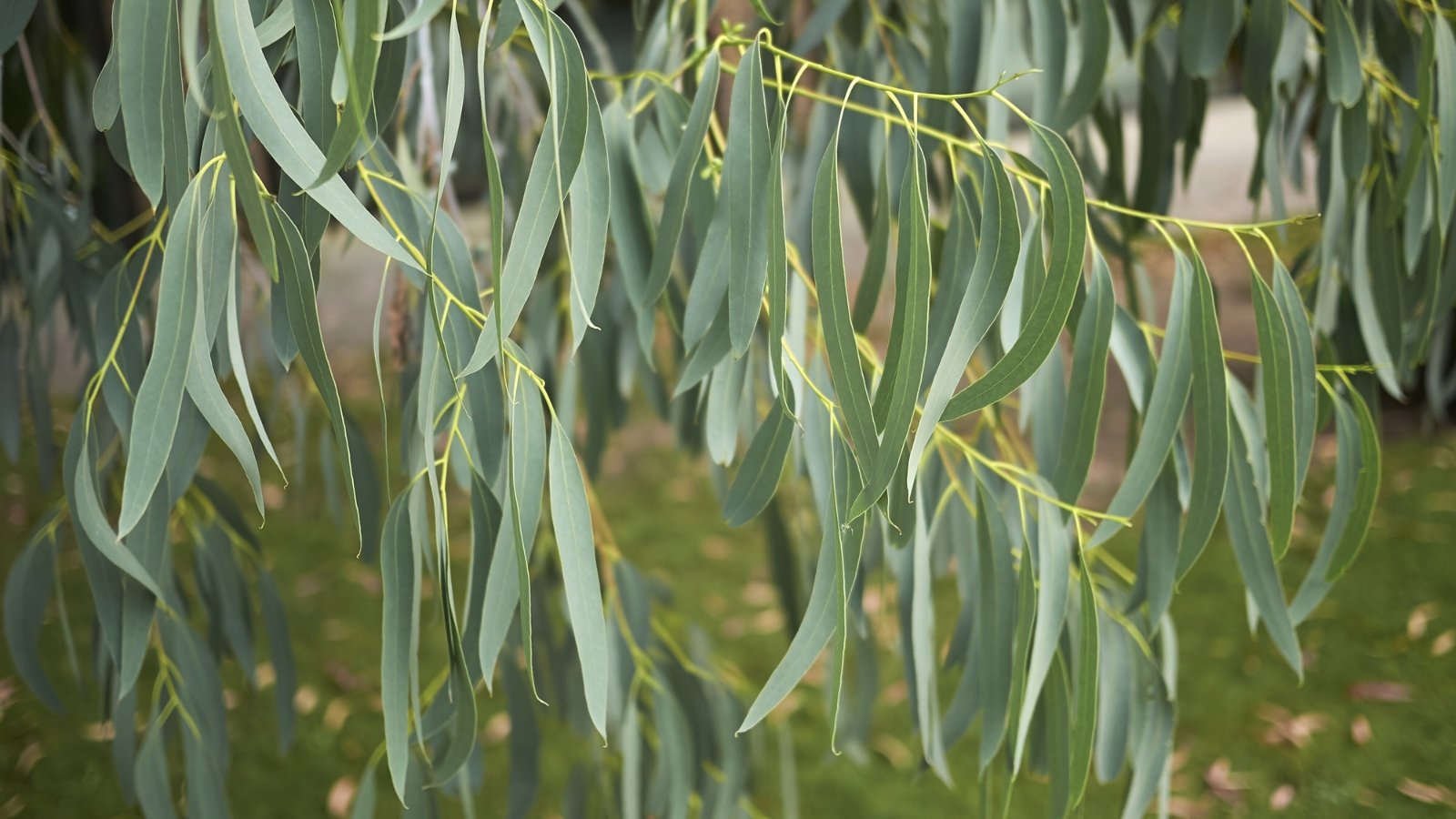
The spinning gum is a eucalyptus tree native to southeastern Australia. You don’t need to live in Australia to grow this tree, but you will need to live in a warm climate. Spinning gum trees will tolerate only very mild winters. They thrive in warm, dry climates with plenty of sun and average-quality, well-drained soil.
Spinning gum leaves are tough and evergreen. These silvery-green crescent-shaped leaves give off a unique eucalyptus-menthol fragrance when rubbed or crushed. Light breezes will cause all the leaves to tremble on the tree, giving it a very lively appearance. Spinning gum tree bark is flat and shades of green and pale gray-brown. It peels off in chunks to give the tree an exotic appearance.
Sugar Maple
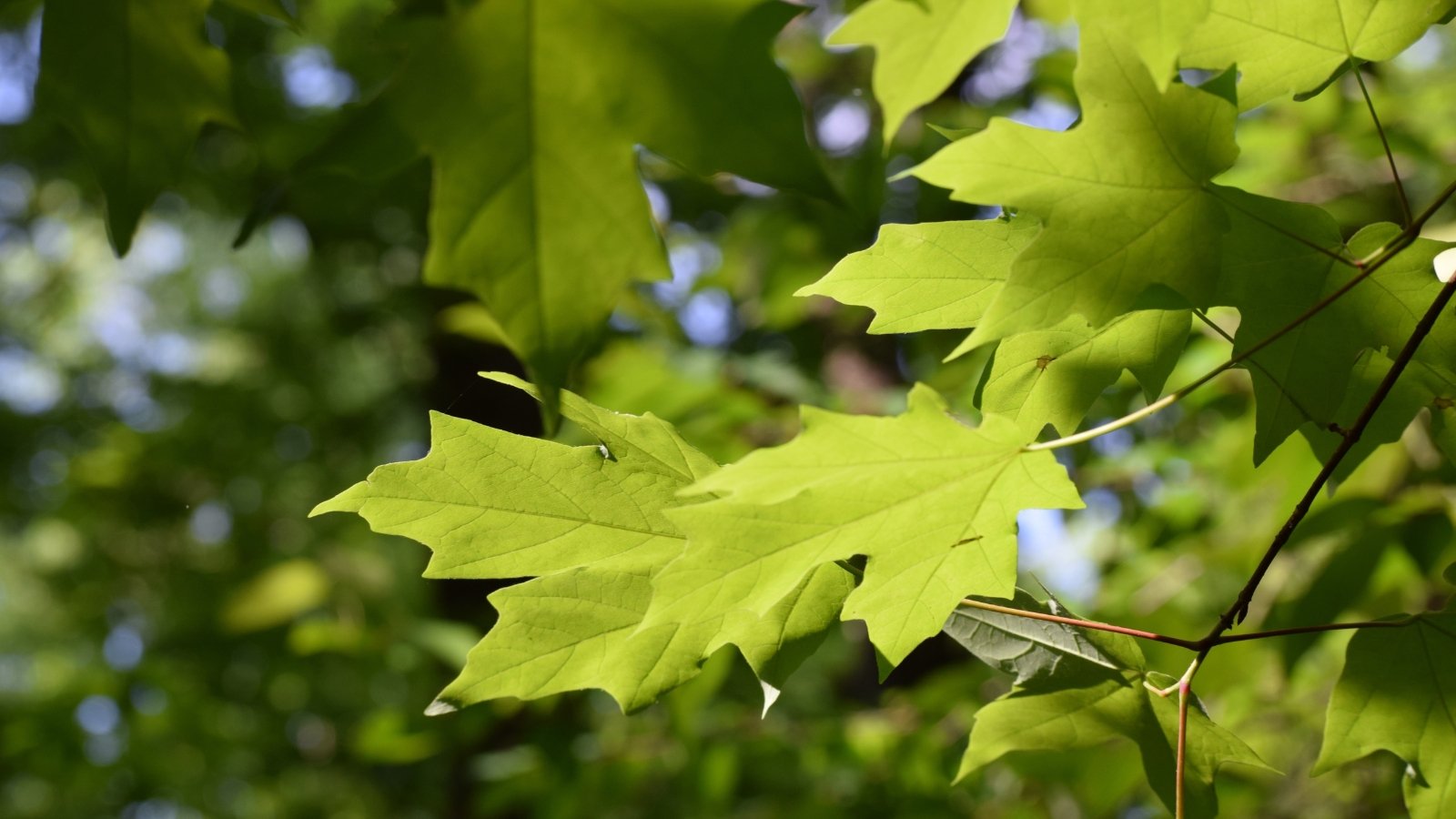
The sugar maple is a popular and easily recognized tree, especially in the fall during the peak of leaf display season. The brilliantly colorful autumn foliage becomes dazzling shades of scarlet red, golden orange, and deep burgundy red. While all maple species display some colorful fall foliage, the sugar maple wins the prize for being the showiest.
Sugar maples prefer cooler regions and won’t perform well in very hot or arid climates. These trees can grow over 100 feet tall, although they may not reach this majestic height in a cultivated landscape. Sugar maples are wonderful trees for a wildlife-friendly landscape, with birds foraging and nesting in the branches, small mammals munching on the flowers and seeds, and pollinators visiting the spring-blooming blossoms.
Tulip Poplar ‘Aureo-Marginatum’
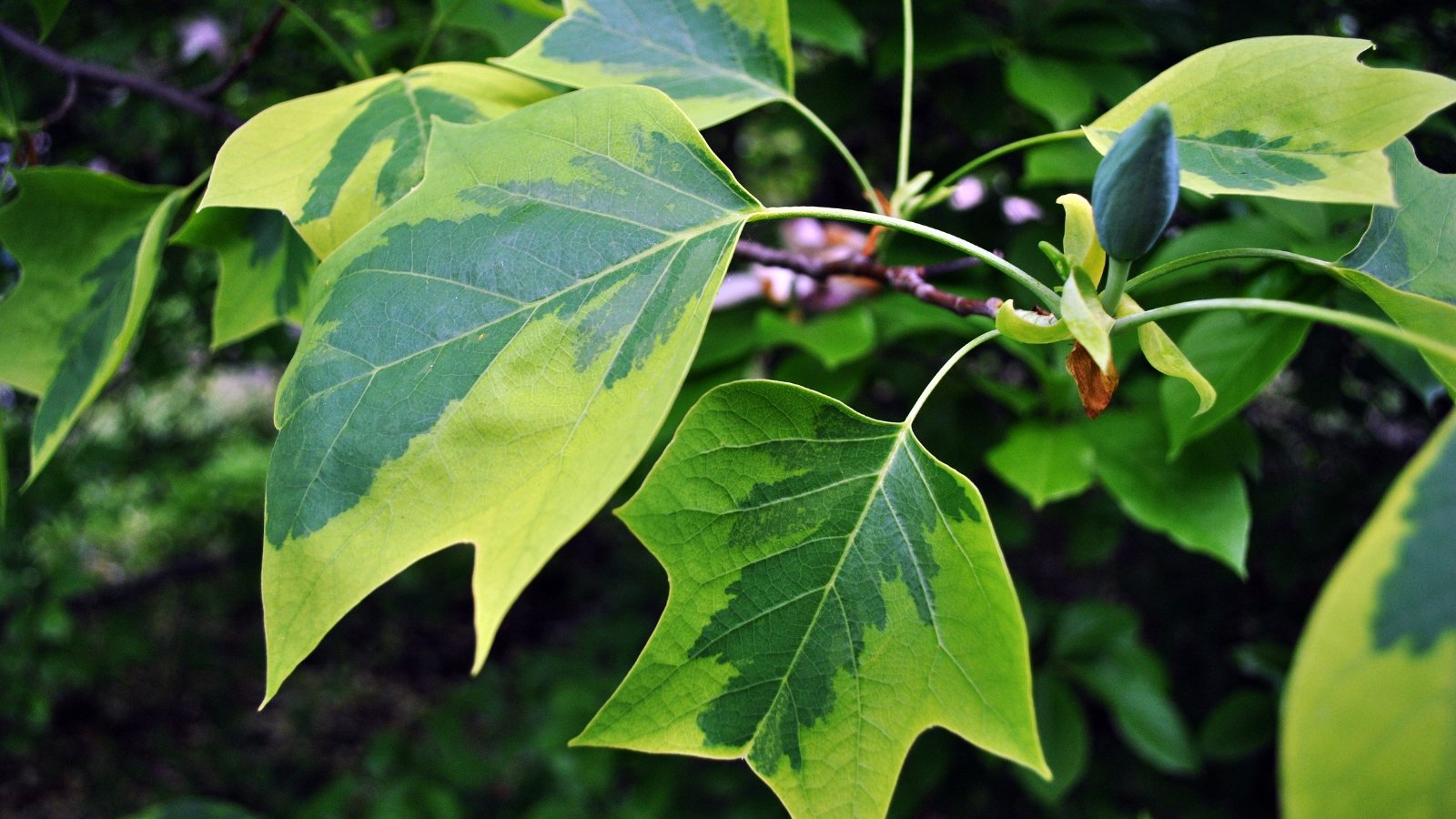
The tulip poplar, also known as tulip tree or yellow poplar, is a large tree native to eastern North America. There are several interesting tulip poplar cultivars, including ‘Aureo-Marginatum.’ This showy variety has variegated leaves. The outer edges are pale yellow-green, while the central section of each leaf is a more typical medium green color. These bi-color leaves really stand out as something different and unusual.
The native tulip poplar can reach over one hundred feet tall, while the ‘Aureo-Marginatum’ cultivar is a bit easier to manage, reaching a maximum height of about 80 feet. Tulip poplars are beautifully flowering trees, although it can be difficult to see the flowers because they’re so high up and blocked by the foliage. Blooming in late spring to early summer, the large, colorful flowers have their own unique appeal.
Variegated Red Twig Dogwood ‘Elegantissima’
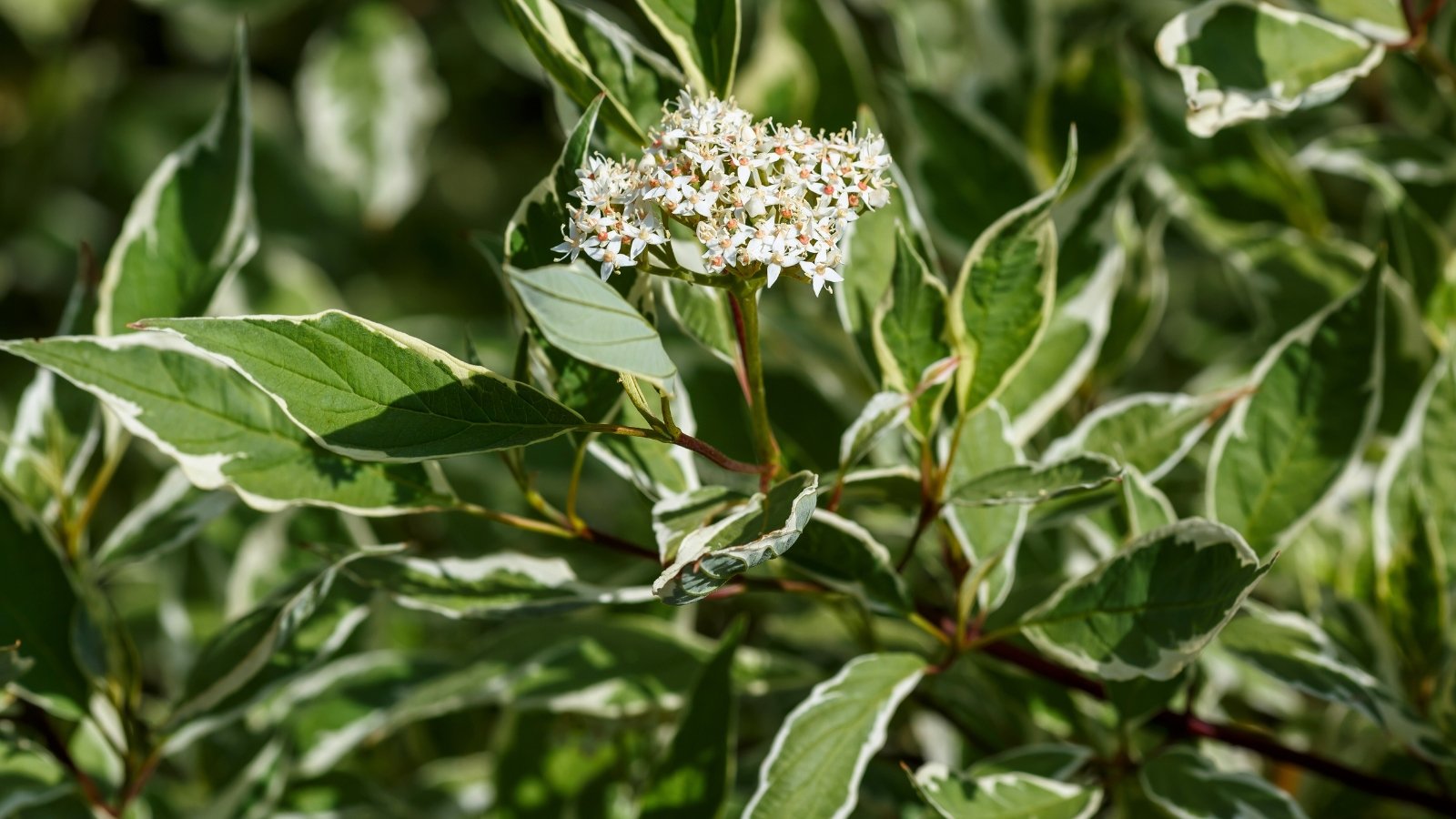
The variegated red twig dogwood has many showy attributes. During the growing season, the first thing you’ll notice about this shrubby tree is its beautifully variegated foliage. Medium green leaves are edged with white, giving it an appealing textured appearance. During the winter, the first thing you’ll notice is its bright red stems! The ‘Elegantissima’ dogwood will catch your attention any time of the year.
The variegated red twig dogwood is a more compact variety than the native dogwood. This cultivar reaches only six to eight feet tall and, when grown in small groups, makes an excellent hedge or showy border. Birds and pollinators will enjoy the spring flowers and the fall fruits, so you will truly have a tree for all seasons.
Weeping Willow
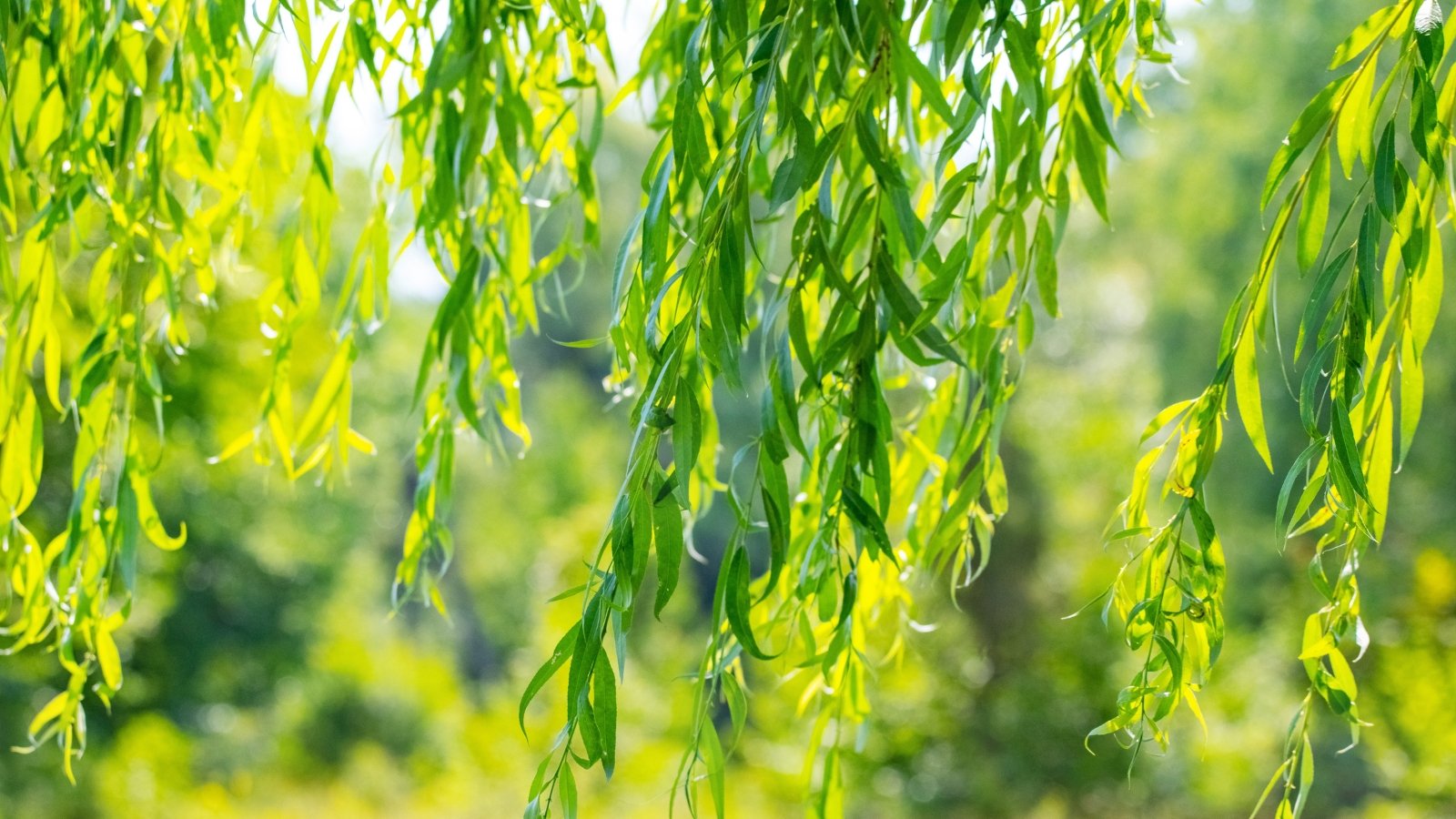
Weeping willows are dramatic, ornamental trees native to China. They love wet soils and are best grown at the edge of a pond or slow-moving stream. Weeping willows perform well in full sun or light shade and make wonderful shade trees themselves with a mature spread of 40 feet. As a landscaping tree, weeping willows are a bit messy, and their fast-growing roots can travel far from the base of the tree, so these trees are best grown in a large space away from structures and utility lines.
Weeping willow trees are easily recognized by their gracefully weeping branches. Each of the thinnest branches is lined with many thin, tapered, lancelike leaves. These leaves are the host plant of the viceroy butterfly, although these caterpillars are extremely well camouflaged, and you may never see them. You will, however, see the colorful adult butterflies flying around, searching for nectar-rich flowers.
Final Thoughts
If you ever thought that trees were simply big, green, and leafy, think again. No matter where you live, you can find trees and shrubs with unique and very showy vegetation. Tree foliage displays numerous showy attributes, including varied colors, a wide range of sizes, and many interesting textures.
And since most trees are hardy and long-lived, if you grow trees that are well-adapted to your local environment, you can enjoy long-term landscaping benefits. Trees are generally low maintenance, they provide wildlife habitat, they can offer shade, and they provide reliable, year-round beauty.
